Gender Inequality in the Construction Industry: A Case Study of One Company in India
VerifiedAdded on 2023/05/31
|21
|3667
|108
AI Summary
This study aims to identify the challenges that women face in the Indian construction industry. The study objectives include identifying the wage difference among women and men working in the Indian construction industry, determining the proportion of female workers in the Indian construction industry, and determining the means of female workers empowerment in the Indian construction industry.
Contribute Materials
Your contribution can guide someone’s learning journey. Share your
documents today.
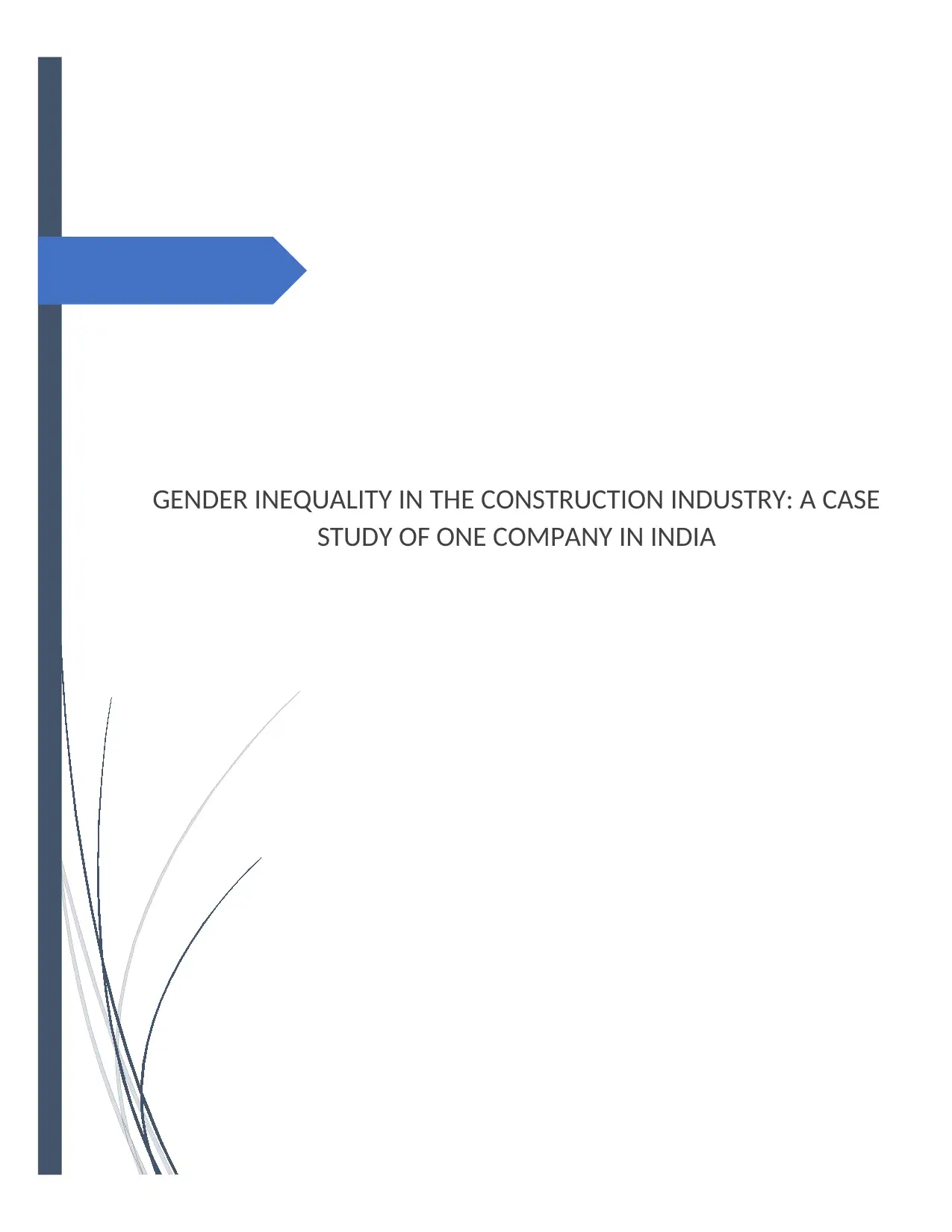
GENDER INEQUALITY IN THE CONSTRUCTION INDUSTRY: A CASE
STUDY OF ONE COMPANY IN INDIA
STUDY OF ONE COMPANY IN INDIA
Secure Best Marks with AI Grader
Need help grading? Try our AI Grader for instant feedback on your assignments.
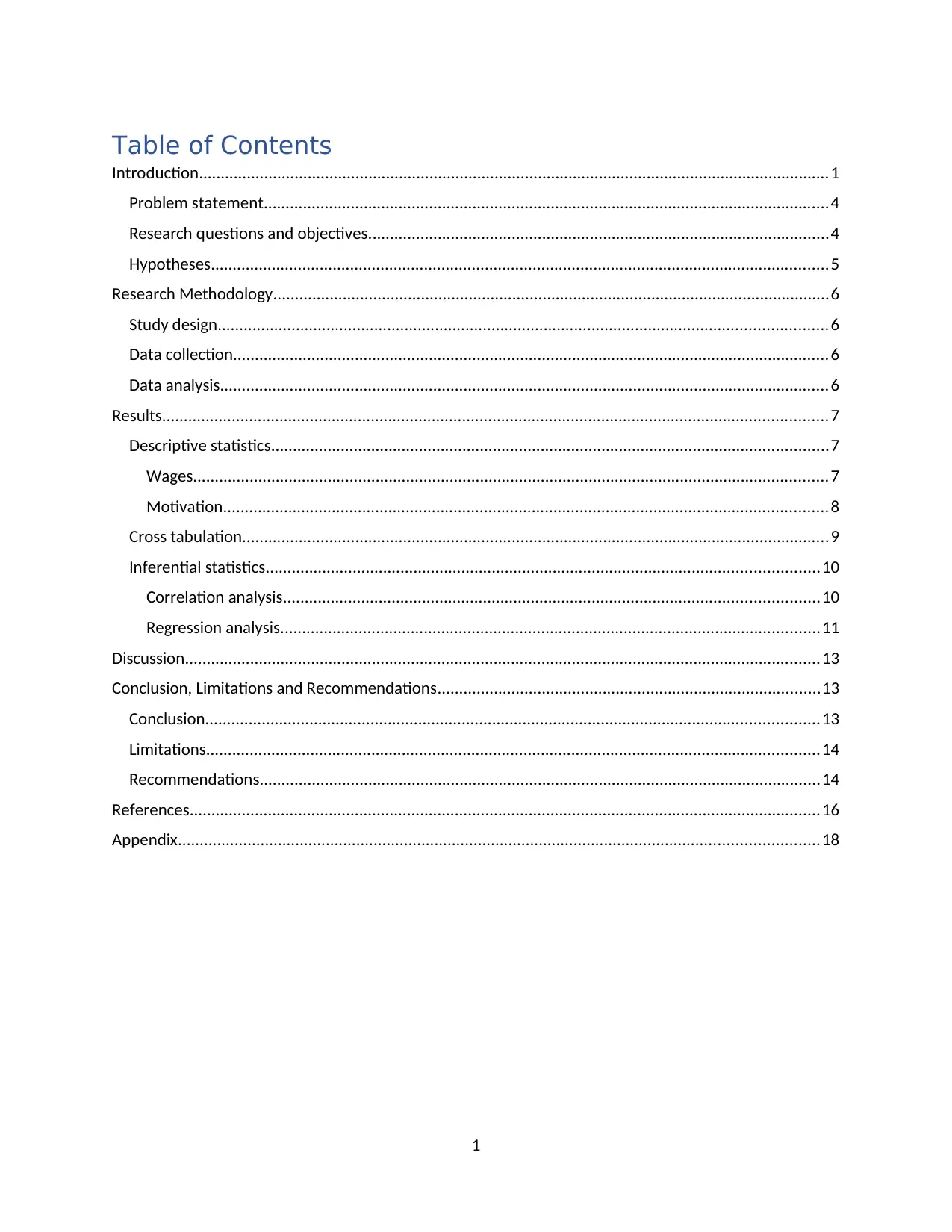
Table of Contents
Introduction.................................................................................................................................................1
Problem statement..................................................................................................................................4
Research questions and objectives..........................................................................................................4
Hypotheses..............................................................................................................................................5
Research Methodology................................................................................................................................6
Study design............................................................................................................................................6
Data collection.........................................................................................................................................6
Data analysis............................................................................................................................................6
Results.........................................................................................................................................................7
Descriptive statistics................................................................................................................................7
Wages..................................................................................................................................................7
Motivation...........................................................................................................................................8
Cross tabulation.......................................................................................................................................9
Inferential statistics...............................................................................................................................10
Correlation analysis...........................................................................................................................10
Regression analysis............................................................................................................................11
Discussion..................................................................................................................................................13
Conclusion, Limitations and Recommendations........................................................................................13
Conclusion.............................................................................................................................................13
Limitations.............................................................................................................................................14
Recommendations.................................................................................................................................14
References.................................................................................................................................................16
Appendix...................................................................................................................................................18
1
Introduction.................................................................................................................................................1
Problem statement..................................................................................................................................4
Research questions and objectives..........................................................................................................4
Hypotheses..............................................................................................................................................5
Research Methodology................................................................................................................................6
Study design............................................................................................................................................6
Data collection.........................................................................................................................................6
Data analysis............................................................................................................................................6
Results.........................................................................................................................................................7
Descriptive statistics................................................................................................................................7
Wages..................................................................................................................................................7
Motivation...........................................................................................................................................8
Cross tabulation.......................................................................................................................................9
Inferential statistics...............................................................................................................................10
Correlation analysis...........................................................................................................................10
Regression analysis............................................................................................................................11
Discussion..................................................................................................................................................13
Conclusion, Limitations and Recommendations........................................................................................13
Conclusion.............................................................................................................................................13
Limitations.............................................................................................................................................14
Recommendations.................................................................................................................................14
References.................................................................................................................................................16
Appendix...................................................................................................................................................18
1
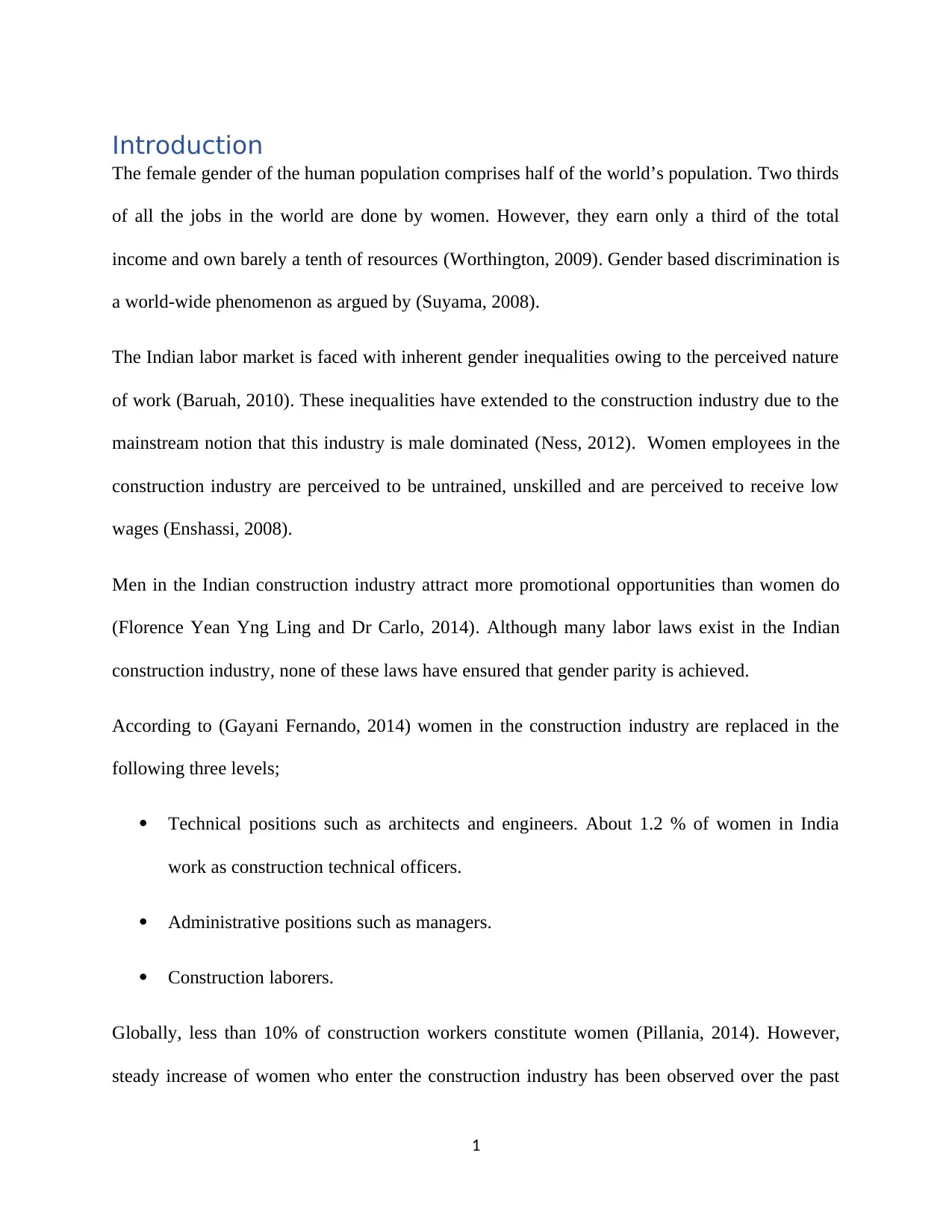
Introduction
The female gender of the human population comprises half of the world’s population. Two thirds
of all the jobs in the world are done by women. However, they earn only a third of the total
income and own barely a tenth of resources (Worthington, 2009). Gender based discrimination is
a world-wide phenomenon as argued by (Suyama, 2008).
The Indian labor market is faced with inherent gender inequalities owing to the perceived nature
of work (Baruah, 2010). These inequalities have extended to the construction industry due to the
mainstream notion that this industry is male dominated (Ness, 2012). Women employees in the
construction industry are perceived to be untrained, unskilled and are perceived to receive low
wages (Enshassi, 2008).
Men in the Indian construction industry attract more promotional opportunities than women do
(Florence Yean Yng Ling and Dr Carlo, 2014). Although many labor laws exist in the Indian
construction industry, none of these laws have ensured that gender parity is achieved.
According to (Gayani Fernando, 2014) women in the construction industry are replaced in the
following three levels;
Technical positions such as architects and engineers. About 1.2 % of women in India
work as construction technical officers.
Administrative positions such as managers.
Construction laborers.
Globally, less than 10% of construction workers constitute women (Pillania, 2014). However,
steady increase of women who enter the construction industry has been observed over the past
1
The female gender of the human population comprises half of the world’s population. Two thirds
of all the jobs in the world are done by women. However, they earn only a third of the total
income and own barely a tenth of resources (Worthington, 2009). Gender based discrimination is
a world-wide phenomenon as argued by (Suyama, 2008).
The Indian labor market is faced with inherent gender inequalities owing to the perceived nature
of work (Baruah, 2010). These inequalities have extended to the construction industry due to the
mainstream notion that this industry is male dominated (Ness, 2012). Women employees in the
construction industry are perceived to be untrained, unskilled and are perceived to receive low
wages (Enshassi, 2008).
Men in the Indian construction industry attract more promotional opportunities than women do
(Florence Yean Yng Ling and Dr Carlo, 2014). Although many labor laws exist in the Indian
construction industry, none of these laws have ensured that gender parity is achieved.
According to (Gayani Fernando, 2014) women in the construction industry are replaced in the
following three levels;
Technical positions such as architects and engineers. About 1.2 % of women in India
work as construction technical officers.
Administrative positions such as managers.
Construction laborers.
Globally, less than 10% of construction workers constitute women (Pillania, 2014). However,
steady increase of women who enter the construction industry has been observed over the past
1
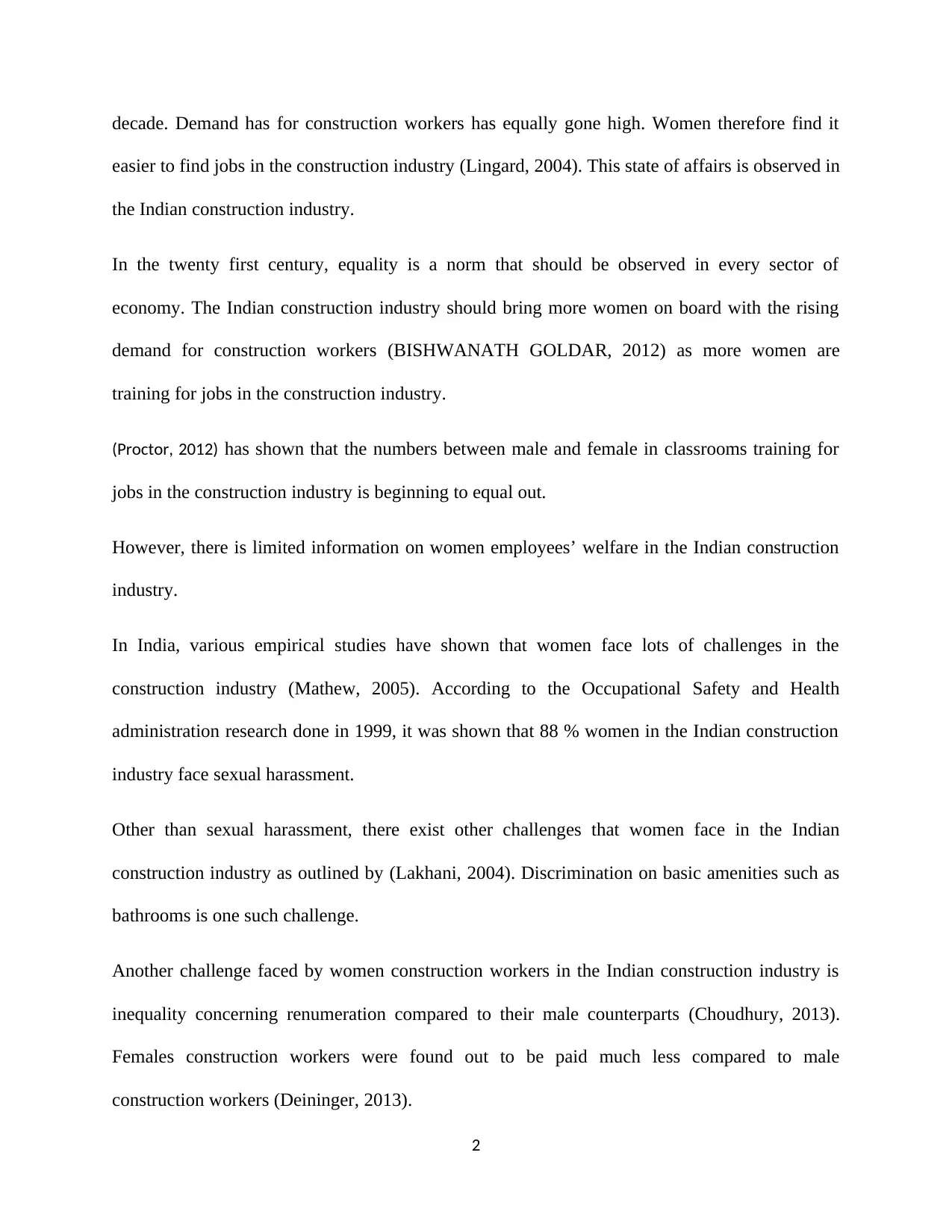
decade. Demand has for construction workers has equally gone high. Women therefore find it
easier to find jobs in the construction industry (Lingard, 2004). This state of affairs is observed in
the Indian construction industry.
In the twenty first century, equality is a norm that should be observed in every sector of
economy. The Indian construction industry should bring more women on board with the rising
demand for construction workers (BISHWANATH GOLDAR, 2012) as more women are
training for jobs in the construction industry.
(Proctor, 2012) has shown that the numbers between male and female in classrooms training for
jobs in the construction industry is beginning to equal out.
However, there is limited information on women employees’ welfare in the Indian construction
industry.
In India, various empirical studies have shown that women face lots of challenges in the
construction industry (Mathew, 2005). According to the Occupational Safety and Health
administration research done in 1999, it was shown that 88 % women in the Indian construction
industry face sexual harassment.
Other than sexual harassment, there exist other challenges that women face in the Indian
construction industry as outlined by (Lakhani, 2004). Discrimination on basic amenities such as
bathrooms is one such challenge.
Another challenge faced by women construction workers in the Indian construction industry is
inequality concerning renumeration compared to their male counterparts (Choudhury, 2013).
Females construction workers were found out to be paid much less compared to male
construction workers (Deininger, 2013).
2
easier to find jobs in the construction industry (Lingard, 2004). This state of affairs is observed in
the Indian construction industry.
In the twenty first century, equality is a norm that should be observed in every sector of
economy. The Indian construction industry should bring more women on board with the rising
demand for construction workers (BISHWANATH GOLDAR, 2012) as more women are
training for jobs in the construction industry.
(Proctor, 2012) has shown that the numbers between male and female in classrooms training for
jobs in the construction industry is beginning to equal out.
However, there is limited information on women employees’ welfare in the Indian construction
industry.
In India, various empirical studies have shown that women face lots of challenges in the
construction industry (Mathew, 2005). According to the Occupational Safety and Health
administration research done in 1999, it was shown that 88 % women in the Indian construction
industry face sexual harassment.
Other than sexual harassment, there exist other challenges that women face in the Indian
construction industry as outlined by (Lakhani, 2004). Discrimination on basic amenities such as
bathrooms is one such challenge.
Another challenge faced by women construction workers in the Indian construction industry is
inequality concerning renumeration compared to their male counterparts (Choudhury, 2013).
Females construction workers were found out to be paid much less compared to male
construction workers (Deininger, 2013).
2
Secure Best Marks with AI Grader
Need help grading? Try our AI Grader for instant feedback on your assignments.
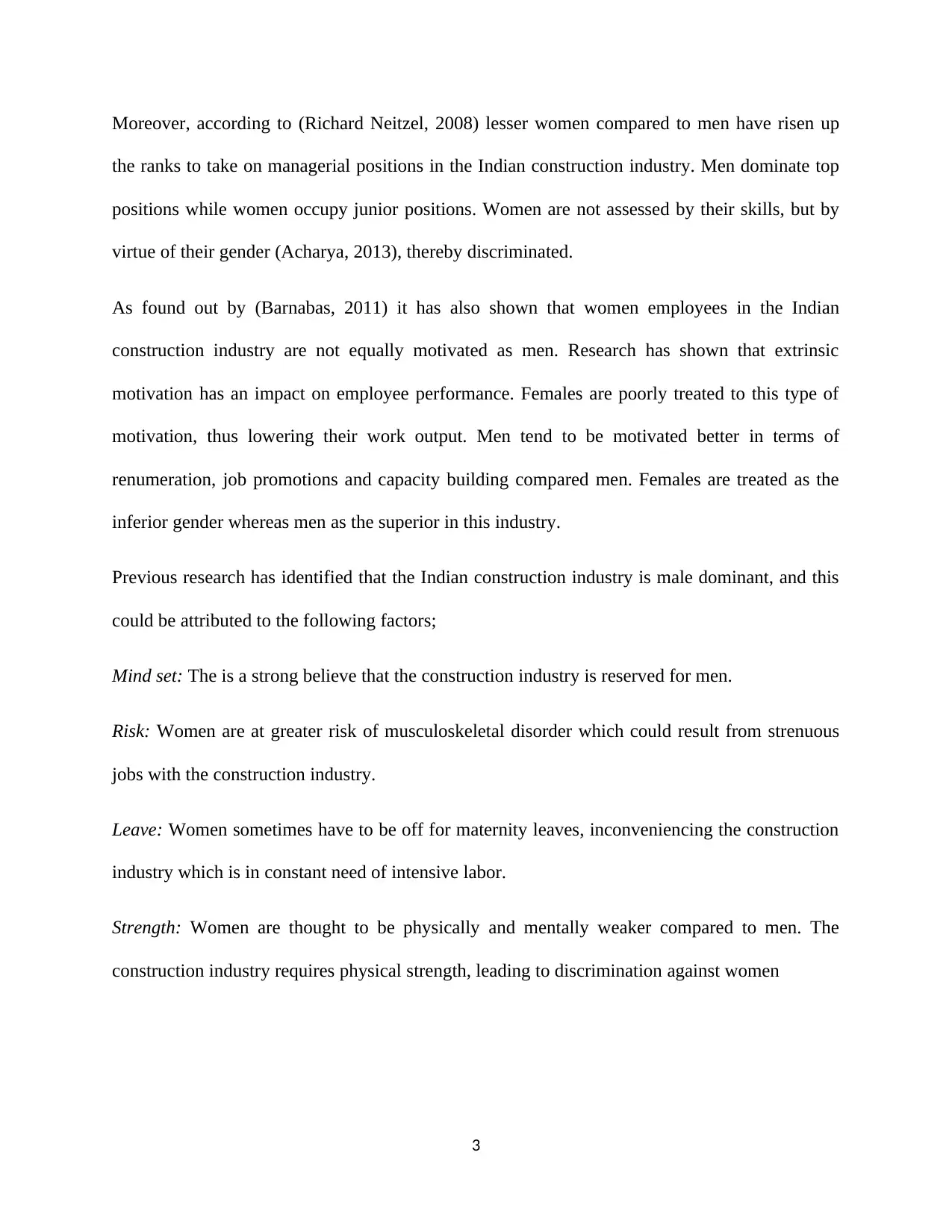
Moreover, according to (Richard Neitzel, 2008) lesser women compared to men have risen up
the ranks to take on managerial positions in the Indian construction industry. Men dominate top
positions while women occupy junior positions. Women are not assessed by their skills, but by
virtue of their gender (Acharya, 2013), thereby discriminated.
As found out by (Barnabas, 2011) it has also shown that women employees in the Indian
construction industry are not equally motivated as men. Research has shown that extrinsic
motivation has an impact on employee performance. Females are poorly treated to this type of
motivation, thus lowering their work output. Men tend to be motivated better in terms of
renumeration, job promotions and capacity building compared men. Females are treated as the
inferior gender whereas men as the superior in this industry.
Previous research has identified that the Indian construction industry is male dominant, and this
could be attributed to the following factors;
Mind set: The is a strong believe that the construction industry is reserved for men.
Risk: Women are at greater risk of musculoskeletal disorder which could result from strenuous
jobs with the construction industry.
Leave: Women sometimes have to be off for maternity leaves, inconveniencing the construction
industry which is in constant need of intensive labor.
Strength: Women are thought to be physically and mentally weaker compared to men. The
construction industry requires physical strength, leading to discrimination against women
3
the ranks to take on managerial positions in the Indian construction industry. Men dominate top
positions while women occupy junior positions. Women are not assessed by their skills, but by
virtue of their gender (Acharya, 2013), thereby discriminated.
As found out by (Barnabas, 2011) it has also shown that women employees in the Indian
construction industry are not equally motivated as men. Research has shown that extrinsic
motivation has an impact on employee performance. Females are poorly treated to this type of
motivation, thus lowering their work output. Men tend to be motivated better in terms of
renumeration, job promotions and capacity building compared men. Females are treated as the
inferior gender whereas men as the superior in this industry.
Previous research has identified that the Indian construction industry is male dominant, and this
could be attributed to the following factors;
Mind set: The is a strong believe that the construction industry is reserved for men.
Risk: Women are at greater risk of musculoskeletal disorder which could result from strenuous
jobs with the construction industry.
Leave: Women sometimes have to be off for maternity leaves, inconveniencing the construction
industry which is in constant need of intensive labor.
Strength: Women are thought to be physically and mentally weaker compared to men. The
construction industry requires physical strength, leading to discrimination against women
3
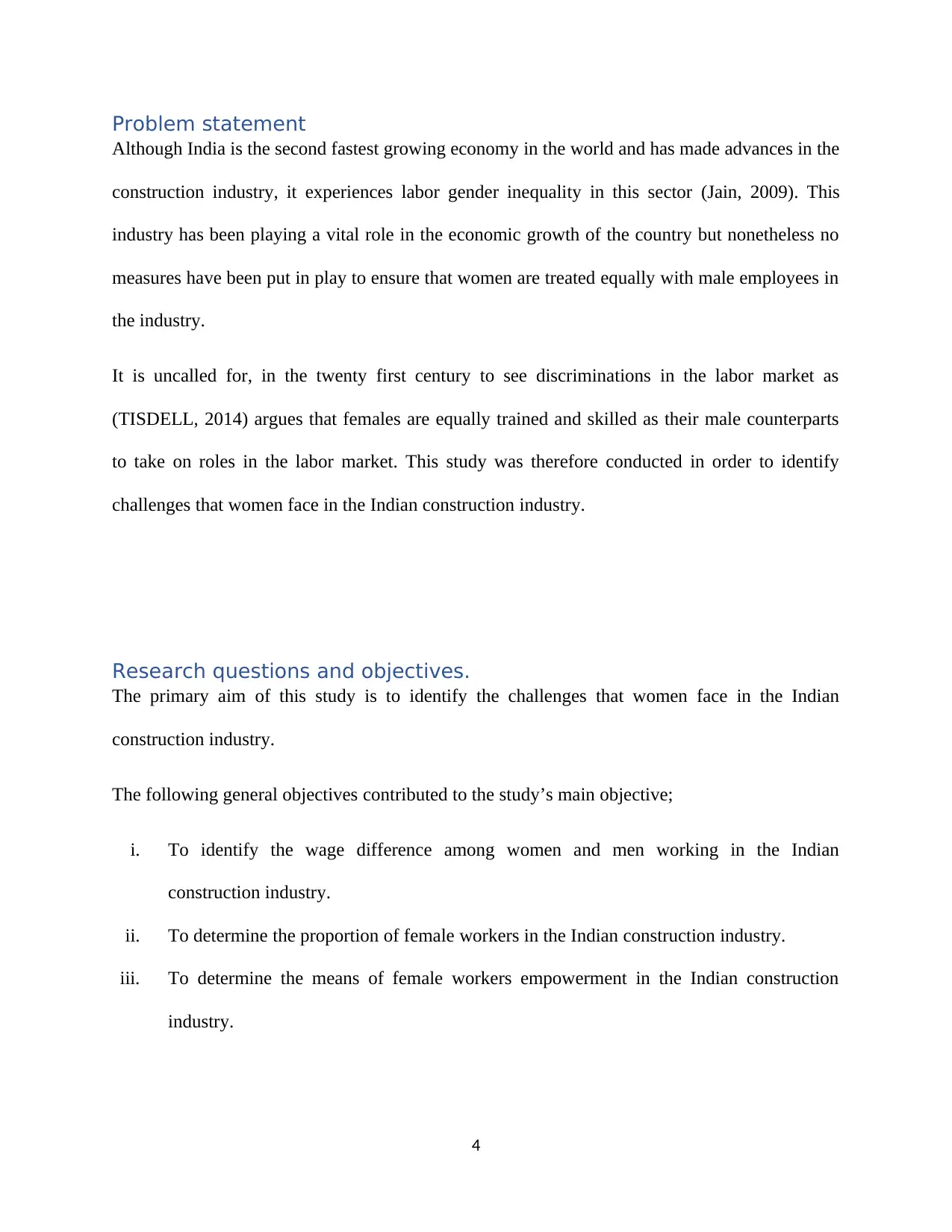
Problem statement
Although India is the second fastest growing economy in the world and has made advances in the
construction industry, it experiences labor gender inequality in this sector (Jain, 2009). This
industry has been playing a vital role in the economic growth of the country but nonetheless no
measures have been put in play to ensure that women are treated equally with male employees in
the industry.
It is uncalled for, in the twenty first century to see discriminations in the labor market as
(TISDELL, 2014) argues that females are equally trained and skilled as their male counterparts
to take on roles in the labor market. This study was therefore conducted in order to identify
challenges that women face in the Indian construction industry.
Research questions and objectives.
The primary aim of this study is to identify the challenges that women face in the Indian
construction industry.
The following general objectives contributed to the study’s main objective;
i. To identify the wage difference among women and men working in the Indian
construction industry.
ii. To determine the proportion of female workers in the Indian construction industry.
iii. To determine the means of female workers empowerment in the Indian construction
industry.
4
Although India is the second fastest growing economy in the world and has made advances in the
construction industry, it experiences labor gender inequality in this sector (Jain, 2009). This
industry has been playing a vital role in the economic growth of the country but nonetheless no
measures have been put in play to ensure that women are treated equally with male employees in
the industry.
It is uncalled for, in the twenty first century to see discriminations in the labor market as
(TISDELL, 2014) argues that females are equally trained and skilled as their male counterparts
to take on roles in the labor market. This study was therefore conducted in order to identify
challenges that women face in the Indian construction industry.
Research questions and objectives.
The primary aim of this study is to identify the challenges that women face in the Indian
construction industry.
The following general objectives contributed to the study’s main objective;
i. To identify the wage difference among women and men working in the Indian
construction industry.
ii. To determine the proportion of female workers in the Indian construction industry.
iii. To determine the means of female workers empowerment in the Indian construction
industry.
4
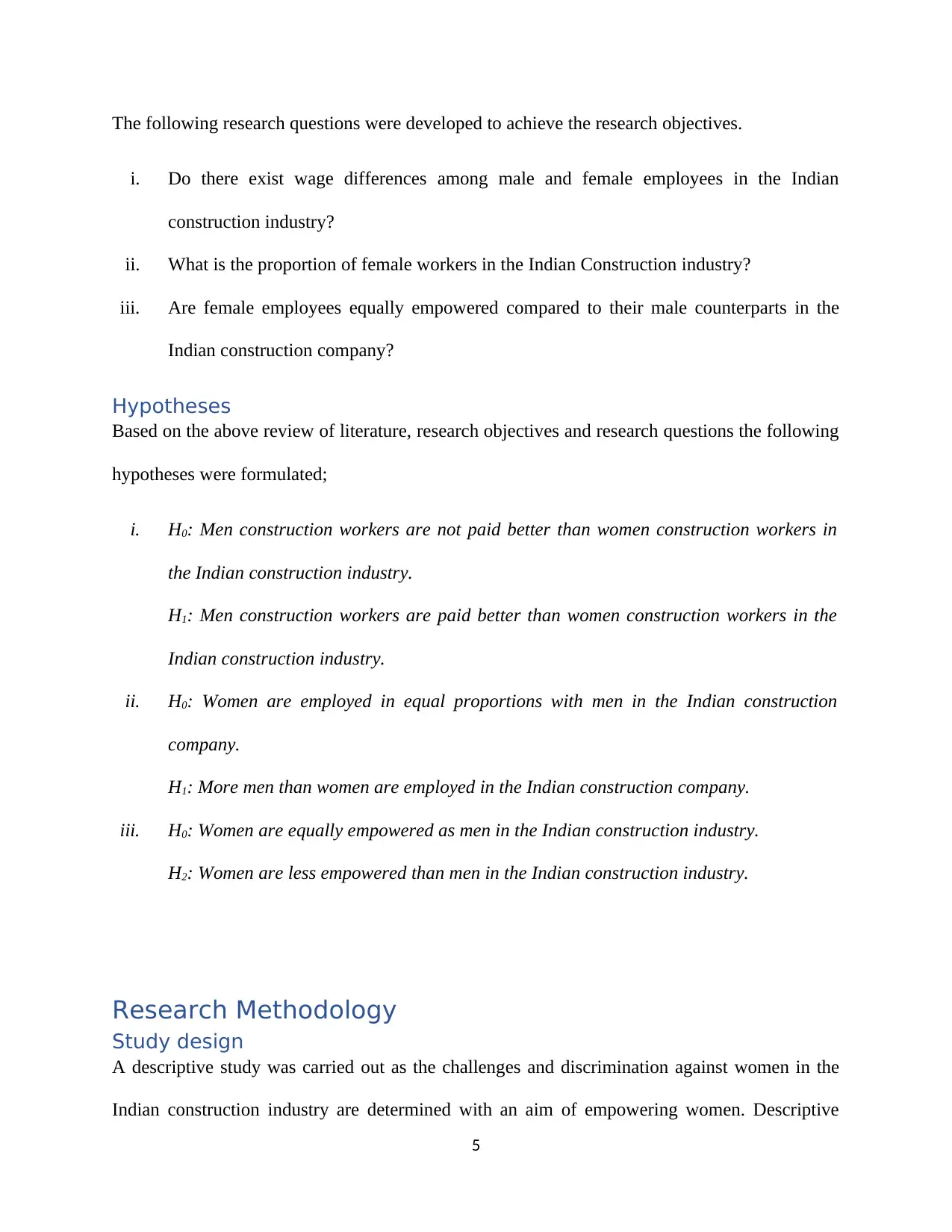
The following research questions were developed to achieve the research objectives.
i. Do there exist wage differences among male and female employees in the Indian
construction industry?
ii. What is the proportion of female workers in the Indian Construction industry?
iii. Are female employees equally empowered compared to their male counterparts in the
Indian construction company?
Hypotheses
Based on the above review of literature, research objectives and research questions the following
hypotheses were formulated;
i. H0: Men construction workers are not paid better than women construction workers in
the Indian construction industry.
H1: Men construction workers are paid better than women construction workers in the
Indian construction industry.
ii. H0: Women are employed in equal proportions with men in the Indian construction
company.
H1: More men than women are employed in the Indian construction company.
iii. H0: Women are equally empowered as men in the Indian construction industry.
H2: Women are less empowered than men in the Indian construction industry.
Research Methodology
Study design
A descriptive study was carried out as the challenges and discrimination against women in the
Indian construction industry are determined with an aim of empowering women. Descriptive
5
i. Do there exist wage differences among male and female employees in the Indian
construction industry?
ii. What is the proportion of female workers in the Indian Construction industry?
iii. Are female employees equally empowered compared to their male counterparts in the
Indian construction company?
Hypotheses
Based on the above review of literature, research objectives and research questions the following
hypotheses were formulated;
i. H0: Men construction workers are not paid better than women construction workers in
the Indian construction industry.
H1: Men construction workers are paid better than women construction workers in the
Indian construction industry.
ii. H0: Women are employed in equal proportions with men in the Indian construction
company.
H1: More men than women are employed in the Indian construction company.
iii. H0: Women are equally empowered as men in the Indian construction industry.
H2: Women are less empowered than men in the Indian construction industry.
Research Methodology
Study design
A descriptive study was carried out as the challenges and discrimination against women in the
Indian construction industry are determined with an aim of empowering women. Descriptive
5
Paraphrase This Document
Need a fresh take? Get an instant paraphrase of this document with our AI Paraphraser
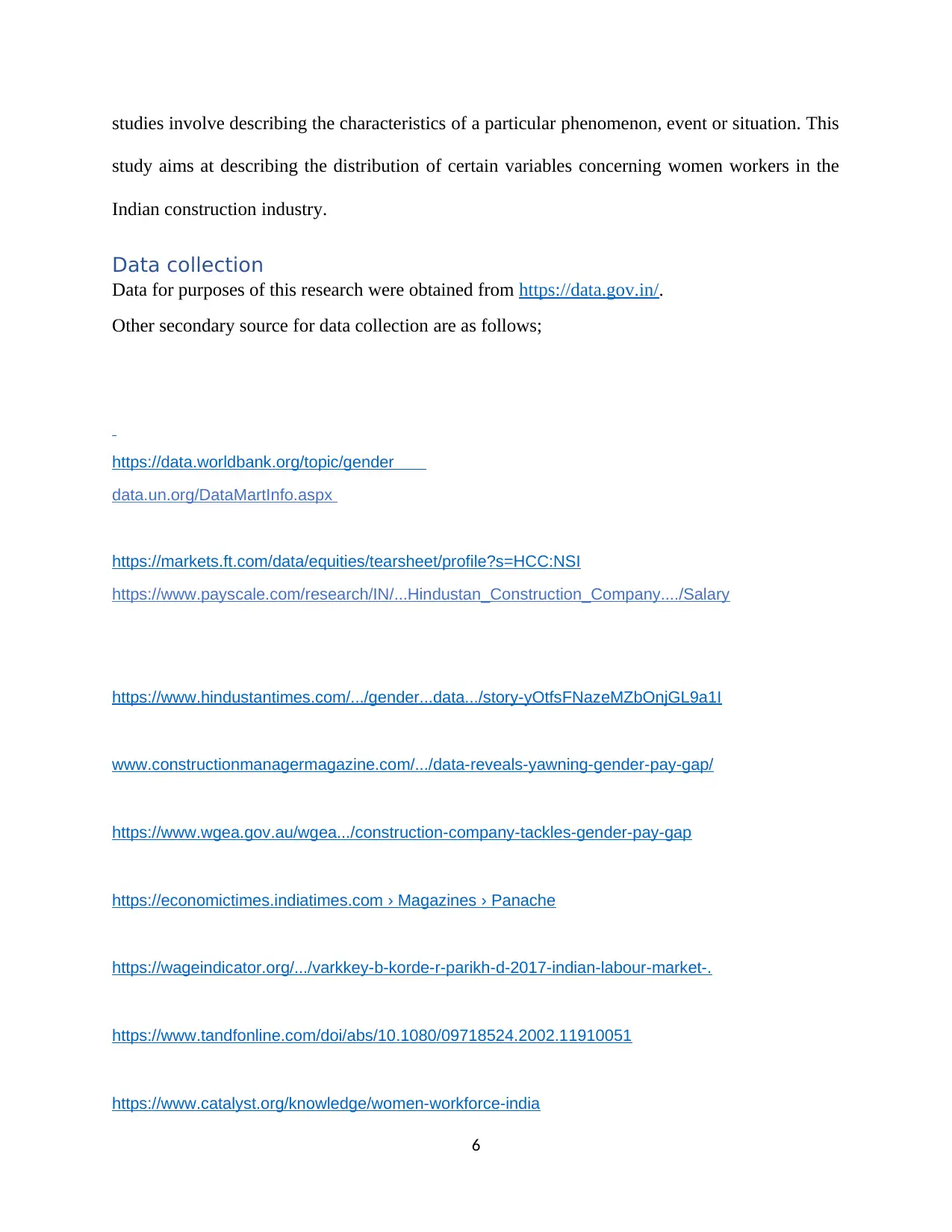
studies involve describing the characteristics of a particular phenomenon, event or situation. This
study aims at describing the distribution of certain variables concerning women workers in the
Indian construction industry.
Data collection
Data for purposes of this research were obtained from https://data.gov.in/.
Other secondary source for data collection are as follows;
https://data.worldbank.org/topic/gender
data.un.org/DataMartInfo.aspx
https://markets.ft.com/data/equities/tearsheet/profile?s=HCC:NSI
https://www.payscale.com/research/IN/...Hindustan_Construction_Company..../Salary
https://www.hindustantimes.com/.../gender...data.../story-yOtfsFNazeMZbOnjGL9a1I
www.constructionmanagermagazine.com/.../data-reveals-yawning-gender-pay-gap/
https://www.wgea.gov.au/wgea.../construction-company-tackles-gender-pay-gap
https://economictimes.indiatimes.com › Magazines › Panache
https://wageindicator.org/.../varkkey-b-korde-r-parikh-d-2017-indian-labour-market-.
https://www.tandfonline.com/doi/abs/10.1080/09718524.2002.11910051
https://www.catalyst.org/knowledge/women-workforce-india
6
study aims at describing the distribution of certain variables concerning women workers in the
Indian construction industry.
Data collection
Data for purposes of this research were obtained from https://data.gov.in/.
Other secondary source for data collection are as follows;
https://data.worldbank.org/topic/gender
data.un.org/DataMartInfo.aspx
https://markets.ft.com/data/equities/tearsheet/profile?s=HCC:NSI
https://www.payscale.com/research/IN/...Hindustan_Construction_Company..../Salary
https://www.hindustantimes.com/.../gender...data.../story-yOtfsFNazeMZbOnjGL9a1I
www.constructionmanagermagazine.com/.../data-reveals-yawning-gender-pay-gap/
https://www.wgea.gov.au/wgea.../construction-company-tackles-gender-pay-gap
https://economictimes.indiatimes.com › Magazines › Panache
https://wageindicator.org/.../varkkey-b-korde-r-parikh-d-2017-indian-labour-market-.
https://www.tandfonline.com/doi/abs/10.1080/09718524.2002.11910051
https://www.catalyst.org/knowledge/women-workforce-india
6
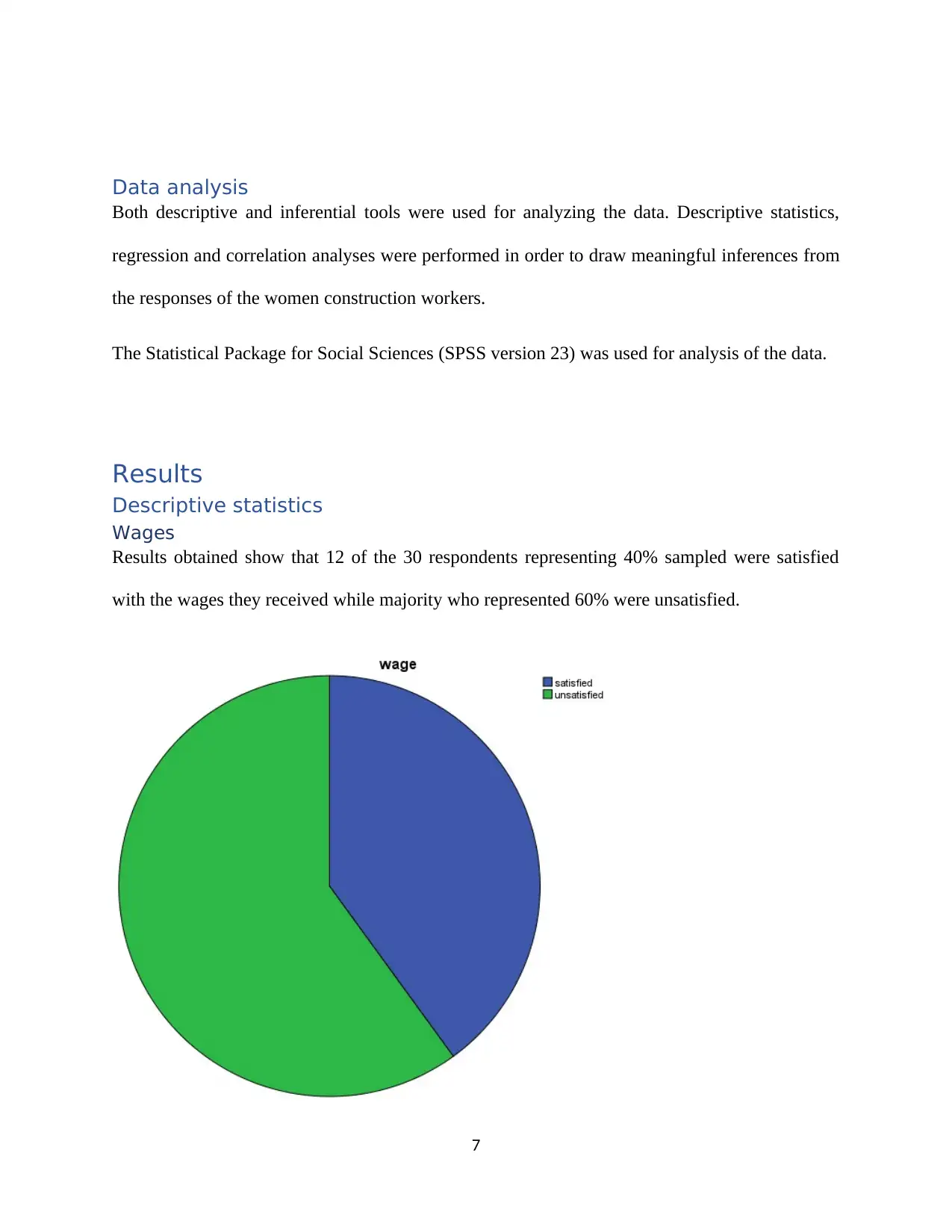
Data analysis
Both descriptive and inferential tools were used for analyzing the data. Descriptive statistics,
regression and correlation analyses were performed in order to draw meaningful inferences from
the responses of the women construction workers.
The Statistical Package for Social Sciences (SPSS version 23) was used for analysis of the data.
Results
Descriptive statistics
Wages
Results obtained show that 12 of the 30 respondents representing 40% sampled were satisfied
with the wages they received while majority who represented 60% were unsatisfied.
7
Both descriptive and inferential tools were used for analyzing the data. Descriptive statistics,
regression and correlation analyses were performed in order to draw meaningful inferences from
the responses of the women construction workers.
The Statistical Package for Social Sciences (SPSS version 23) was used for analysis of the data.
Results
Descriptive statistics
Wages
Results obtained show that 12 of the 30 respondents representing 40% sampled were satisfied
with the wages they received while majority who represented 60% were unsatisfied.
7
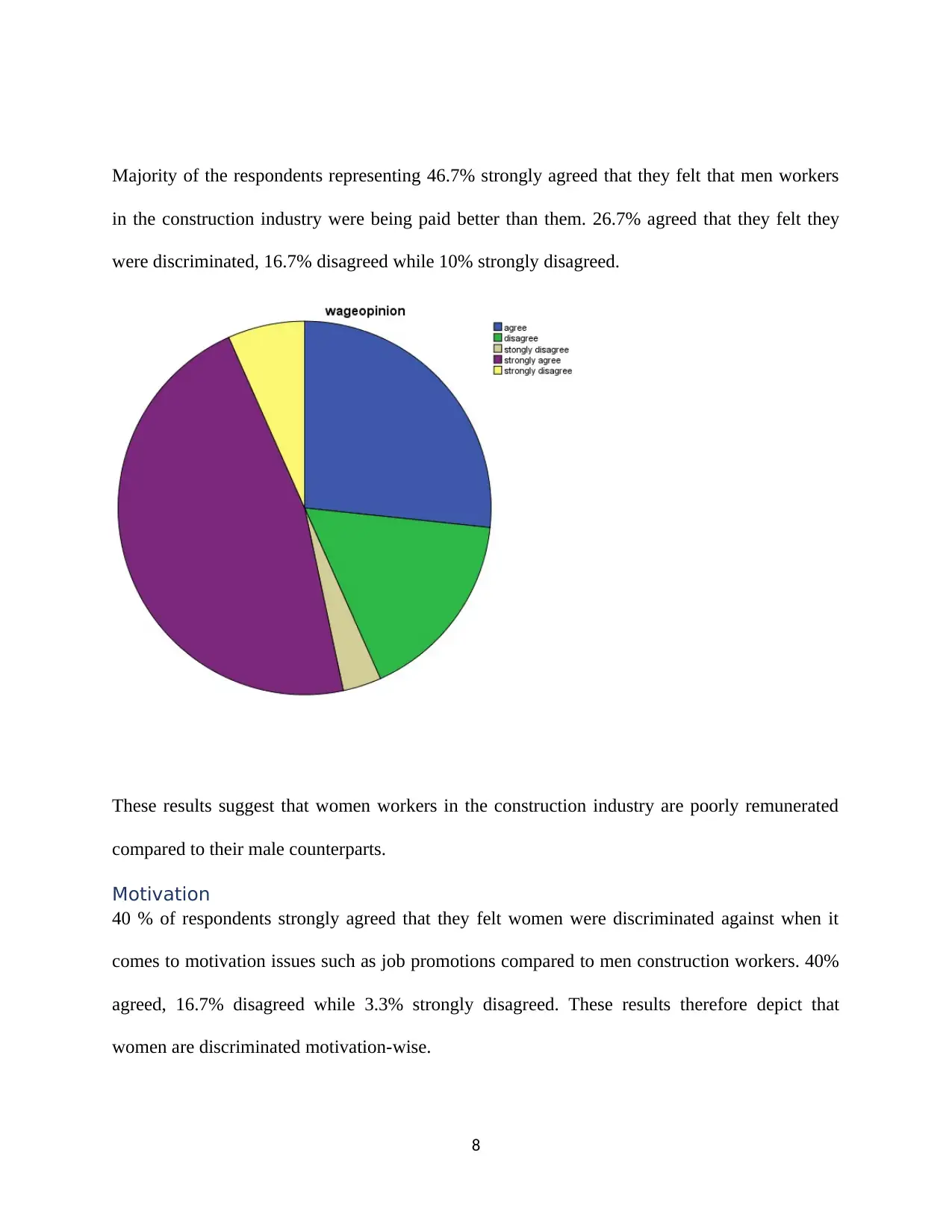
Majority of the respondents representing 46.7% strongly agreed that they felt that men workers
in the construction industry were being paid better than them. 26.7% agreed that they felt they
were discriminated, 16.7% disagreed while 10% strongly disagreed.
These results suggest that women workers in the construction industry are poorly remunerated
compared to their male counterparts.
Motivation
40 % of respondents strongly agreed that they felt women were discriminated against when it
comes to motivation issues such as job promotions compared to men construction workers. 40%
agreed, 16.7% disagreed while 3.3% strongly disagreed. These results therefore depict that
women are discriminated motivation-wise.
8
in the construction industry were being paid better than them. 26.7% agreed that they felt they
were discriminated, 16.7% disagreed while 10% strongly disagreed.
These results suggest that women workers in the construction industry are poorly remunerated
compared to their male counterparts.
Motivation
40 % of respondents strongly agreed that they felt women were discriminated against when it
comes to motivation issues such as job promotions compared to men construction workers. 40%
agreed, 16.7% disagreed while 3.3% strongly disagreed. These results therefore depict that
women are discriminated motivation-wise.
8
Secure Best Marks with AI Grader
Need help grading? Try our AI Grader for instant feedback on your assignments.
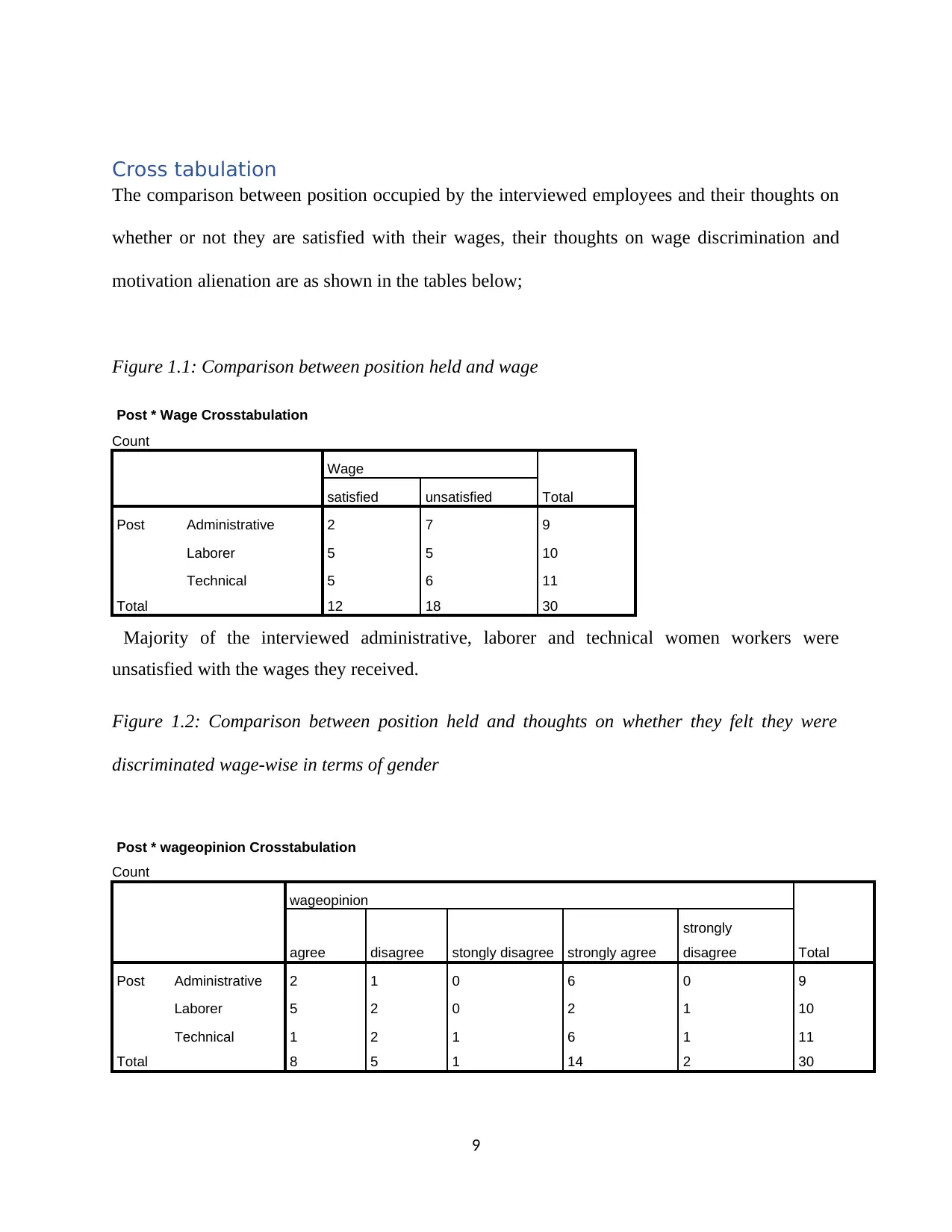
Cross tabulation
The comparison between position occupied by the interviewed employees and their thoughts on
whether or not they are satisfied with their wages, their thoughts on wage discrimination and
motivation alienation are as shown in the tables below;
Figure 1.1: Comparison between position held and wage
Post * Wage Crosstabulation
Count
Wage
Totalsatisfied unsatisfied
Post Administrative 2 7 9
Laborer 5 5 10
Technical 5 6 11
Total 12 18 30
Majority of the interviewed administrative, laborer and technical women workers were
unsatisfied with the wages they received.
Figure 1.2: Comparison between position held and thoughts on whether they felt they were
discriminated wage-wise in terms of gender
Post * wageopinion Crosstabulation
Count
wageopinion
Totalagree disagree stongly disagree strongly agree
strongly
disagree
Post Administrative 2 1 0 6 0 9
Laborer 5 2 0 2 1 10
Technical 1 2 1 6 1 11
Total 8 5 1 14 2 30
9
The comparison between position occupied by the interviewed employees and their thoughts on
whether or not they are satisfied with their wages, their thoughts on wage discrimination and
motivation alienation are as shown in the tables below;
Figure 1.1: Comparison between position held and wage
Post * Wage Crosstabulation
Count
Wage
Totalsatisfied unsatisfied
Post Administrative 2 7 9
Laborer 5 5 10
Technical 5 6 11
Total 12 18 30
Majority of the interviewed administrative, laborer and technical women workers were
unsatisfied with the wages they received.
Figure 1.2: Comparison between position held and thoughts on whether they felt they were
discriminated wage-wise in terms of gender
Post * wageopinion Crosstabulation
Count
wageopinion
Totalagree disagree stongly disagree strongly agree
strongly
disagree
Post Administrative 2 1 0 6 0 9
Laborer 5 2 0 2 1 10
Technical 1 2 1 6 1 11
Total 8 5 1 14 2 30
9
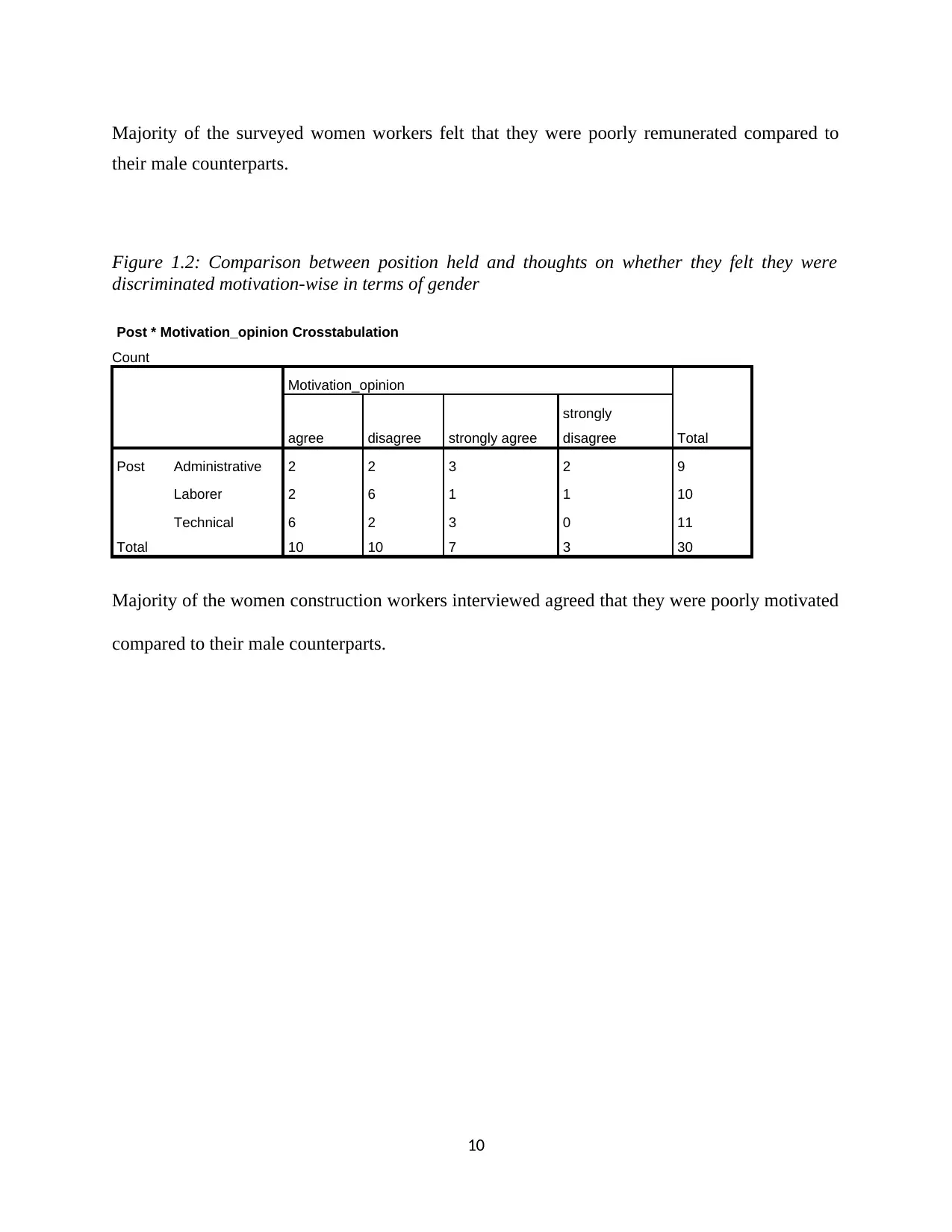
Majority of the surveyed women workers felt that they were poorly remunerated compared to
their male counterparts.
Figure 1.2: Comparison between position held and thoughts on whether they felt they were
discriminated motivation-wise in terms of gender
Post * Motivation_opinion Crosstabulation
Count
Motivation_opinion
Totalagree disagree strongly agree
strongly
disagree
Post Administrative 2 2 3 2 9
Laborer 2 6 1 1 10
Technical 6 2 3 0 11
Total 10 10 7 3 30
Majority of the women construction workers interviewed agreed that they were poorly motivated
compared to their male counterparts.
10
their male counterparts.
Figure 1.2: Comparison between position held and thoughts on whether they felt they were
discriminated motivation-wise in terms of gender
Post * Motivation_opinion Crosstabulation
Count
Motivation_opinion
Totalagree disagree strongly agree
strongly
disagree
Post Administrative 2 2 3 2 9
Laborer 2 6 1 1 10
Technical 6 2 3 0 11
Total 10 10 7 3 30
Majority of the women construction workers interviewed agreed that they were poorly motivated
compared to their male counterparts.
10
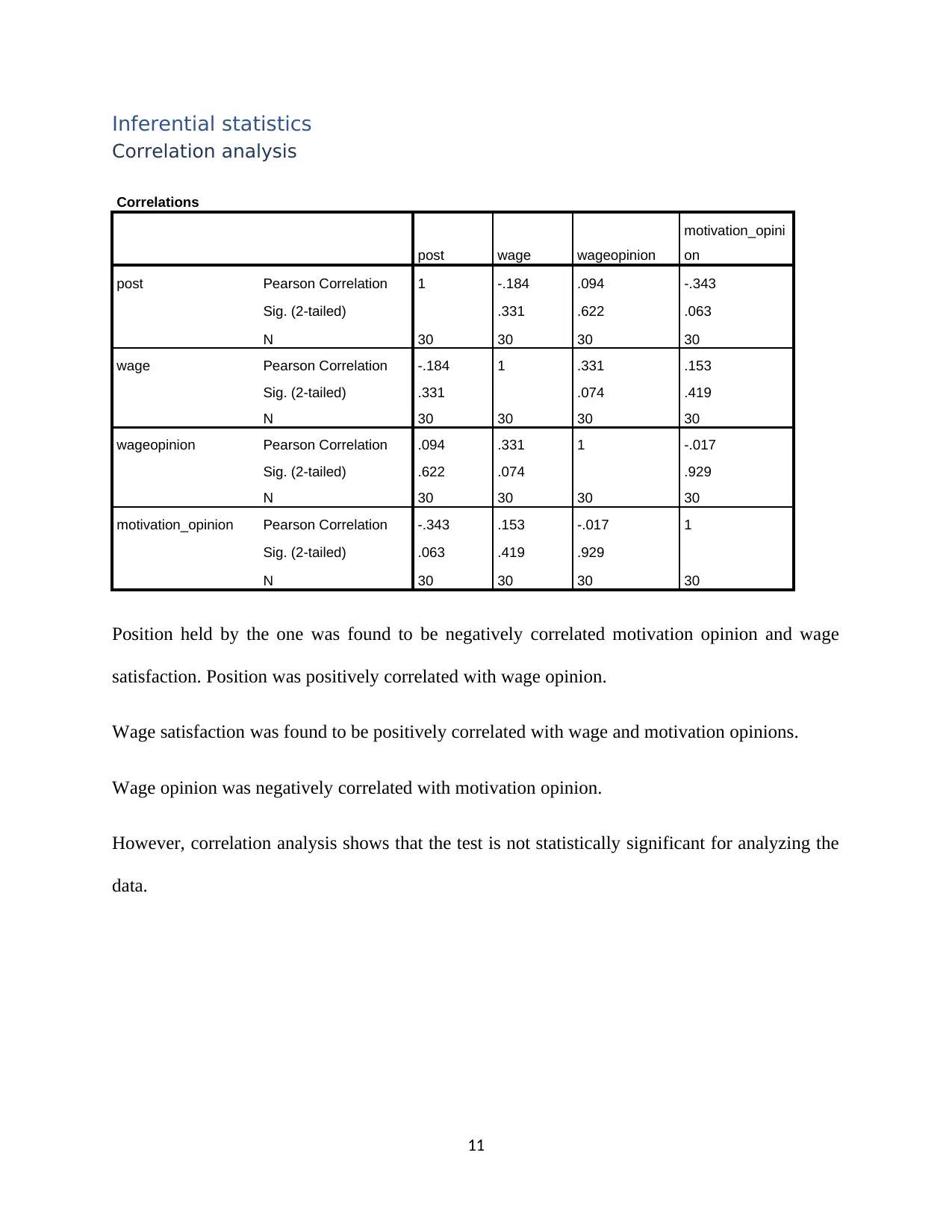
Inferential statistics
Correlation analysis
Correlations
post wage wageopinion
motivation_opini
on
post Pearson Correlation 1 -.184 .094 -.343
Sig. (2-tailed) .331 .622 .063
N 30 30 30 30
wage Pearson Correlation -.184 1 .331 .153
Sig. (2-tailed) .331 .074 .419
N 30 30 30 30
wageopinion Pearson Correlation .094 .331 1 -.017
Sig. (2-tailed) .622 .074 .929
N 30 30 30 30
motivation_opinion Pearson Correlation -.343 .153 -.017 1
Sig. (2-tailed) .063 .419 .929
N 30 30 30 30
Position held by the one was found to be negatively correlated motivation opinion and wage
satisfaction. Position was positively correlated with wage opinion.
Wage satisfaction was found to be positively correlated with wage and motivation opinions.
Wage opinion was negatively correlated with motivation opinion.
However, correlation analysis shows that the test is not statistically significant for analyzing the
data.
11
Correlation analysis
Correlations
post wage wageopinion
motivation_opini
on
post Pearson Correlation 1 -.184 .094 -.343
Sig. (2-tailed) .331 .622 .063
N 30 30 30 30
wage Pearson Correlation -.184 1 .331 .153
Sig. (2-tailed) .331 .074 .419
N 30 30 30 30
wageopinion Pearson Correlation .094 .331 1 -.017
Sig. (2-tailed) .622 .074 .929
N 30 30 30 30
motivation_opinion Pearson Correlation -.343 .153 -.017 1
Sig. (2-tailed) .063 .419 .929
N 30 30 30 30
Position held by the one was found to be negatively correlated motivation opinion and wage
satisfaction. Position was positively correlated with wage opinion.
Wage satisfaction was found to be positively correlated with wage and motivation opinions.
Wage opinion was negatively correlated with motivation opinion.
However, correlation analysis shows that the test is not statistically significant for analyzing the
data.
11
Paraphrase This Document
Need a fresh take? Get an instant paraphrase of this document with our AI Paraphraser
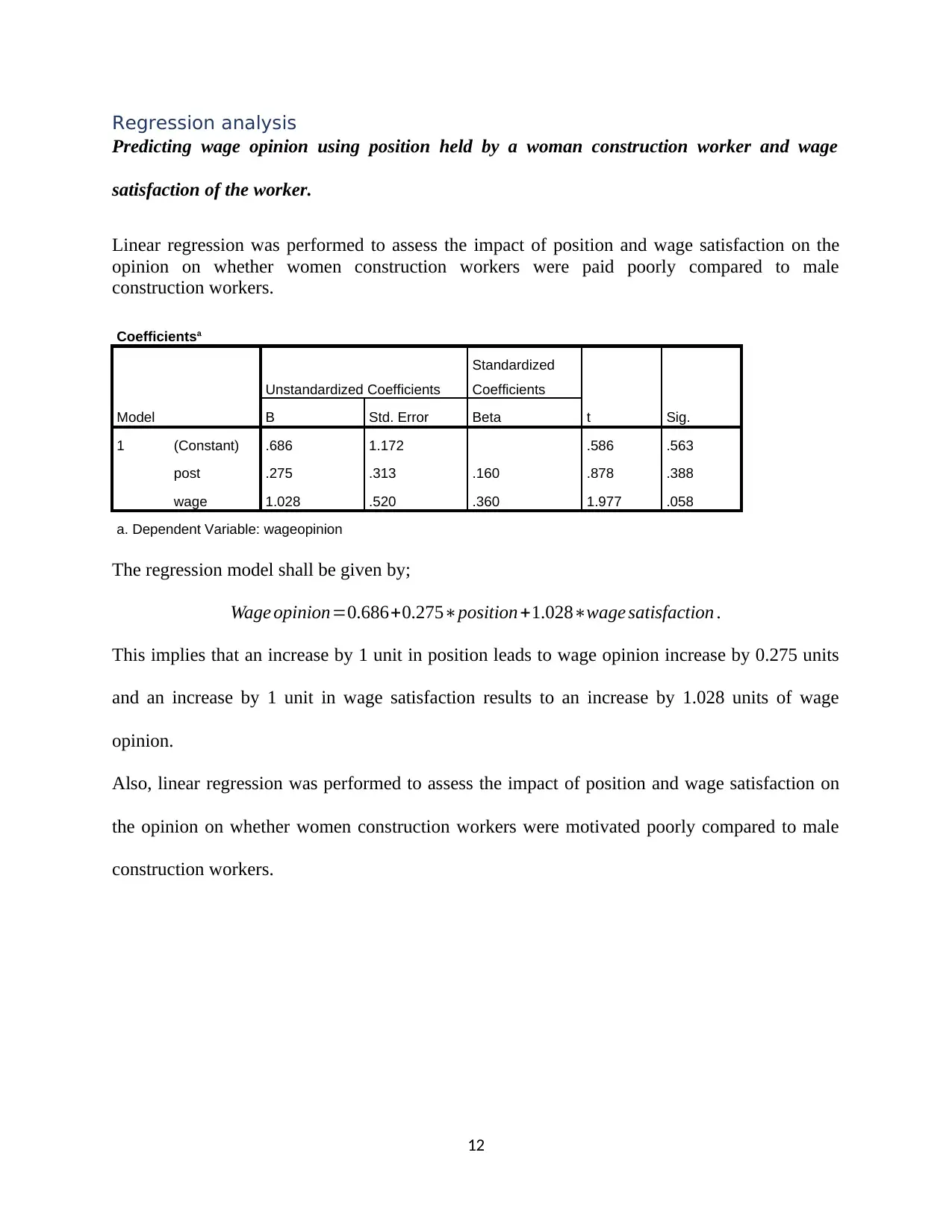
Regression analysis
Predicting wage opinion using position held by a woman construction worker and wage
satisfaction of the worker.
Linear regression was performed to assess the impact of position and wage satisfaction on the
opinion on whether women construction workers were paid poorly compared to male
construction workers.
Coefficientsa
Model
Unstandardized Coefficients
Standardized
Coefficients
t Sig.B Std. Error Beta
1 (Constant) .686 1.172 .586 .563
post .275 .313 .160 .878 .388
wage 1.028 .520 .360 1.977 .058
a. Dependent Variable: wageopinion
The regression model shall be given by;
Wage opinion=0.686+0.275∗position +1.028∗wage satisfaction .
This implies that an increase by 1 unit in position leads to wage opinion increase by 0.275 units
and an increase by 1 unit in wage satisfaction results to an increase by 1.028 units of wage
opinion.
Also, linear regression was performed to assess the impact of position and wage satisfaction on
the opinion on whether women construction workers were motivated poorly compared to male
construction workers.
12
Predicting wage opinion using position held by a woman construction worker and wage
satisfaction of the worker.
Linear regression was performed to assess the impact of position and wage satisfaction on the
opinion on whether women construction workers were paid poorly compared to male
construction workers.
Coefficientsa
Model
Unstandardized Coefficients
Standardized
Coefficients
t Sig.B Std. Error Beta
1 (Constant) .686 1.172 .586 .563
post .275 .313 .160 .878 .388
wage 1.028 .520 .360 1.977 .058
a. Dependent Variable: wageopinion
The regression model shall be given by;
Wage opinion=0.686+0.275∗position +1.028∗wage satisfaction .
This implies that an increase by 1 unit in position leads to wage opinion increase by 0.275 units
and an increase by 1 unit in wage satisfaction results to an increase by 1.028 units of wage
opinion.
Also, linear regression was performed to assess the impact of position and wage satisfaction on
the opinion on whether women construction workers were motivated poorly compared to male
construction workers.
12
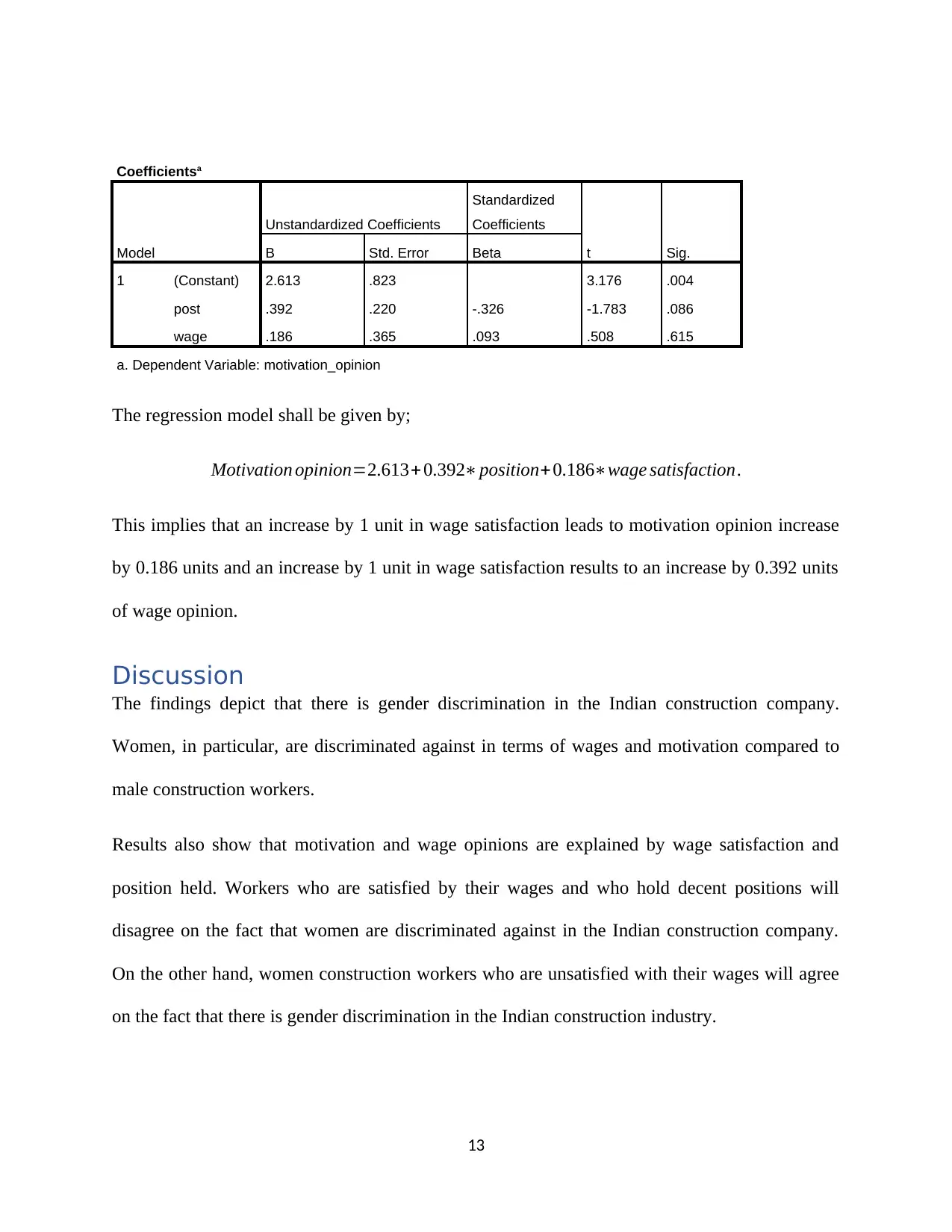
Coefficientsa
Model
Unstandardized Coefficients
Standardized
Coefficients
t Sig.B Std. Error Beta
1 (Constant) 2.613 .823 3.176 .004
post .392 .220 -.326 -1.783 .086
wage .186 .365 .093 .508 .615
a. Dependent Variable: motivation_opinion
The regression model shall be given by;
Motivation opinion=2.613+ 0.392∗position+ 0.186∗wage satisfaction.
This implies that an increase by 1 unit in wage satisfaction leads to motivation opinion increase
by 0.186 units and an increase by 1 unit in wage satisfaction results to an increase by 0.392 units
of wage opinion.
Discussion
The findings depict that there is gender discrimination in the Indian construction company.
Women, in particular, are discriminated against in terms of wages and motivation compared to
male construction workers.
Results also show that motivation and wage opinions are explained by wage satisfaction and
position held. Workers who are satisfied by their wages and who hold decent positions will
disagree on the fact that women are discriminated against in the Indian construction company.
On the other hand, women construction workers who are unsatisfied with their wages will agree
on the fact that there is gender discrimination in the Indian construction industry.
13
Model
Unstandardized Coefficients
Standardized
Coefficients
t Sig.B Std. Error Beta
1 (Constant) 2.613 .823 3.176 .004
post .392 .220 -.326 -1.783 .086
wage .186 .365 .093 .508 .615
a. Dependent Variable: motivation_opinion
The regression model shall be given by;
Motivation opinion=2.613+ 0.392∗position+ 0.186∗wage satisfaction.
This implies that an increase by 1 unit in wage satisfaction leads to motivation opinion increase
by 0.186 units and an increase by 1 unit in wage satisfaction results to an increase by 0.392 units
of wage opinion.
Discussion
The findings depict that there is gender discrimination in the Indian construction company.
Women, in particular, are discriminated against in terms of wages and motivation compared to
male construction workers.
Results also show that motivation and wage opinions are explained by wage satisfaction and
position held. Workers who are satisfied by their wages and who hold decent positions will
disagree on the fact that women are discriminated against in the Indian construction company.
On the other hand, women construction workers who are unsatisfied with their wages will agree
on the fact that there is gender discrimination in the Indian construction industry.
13
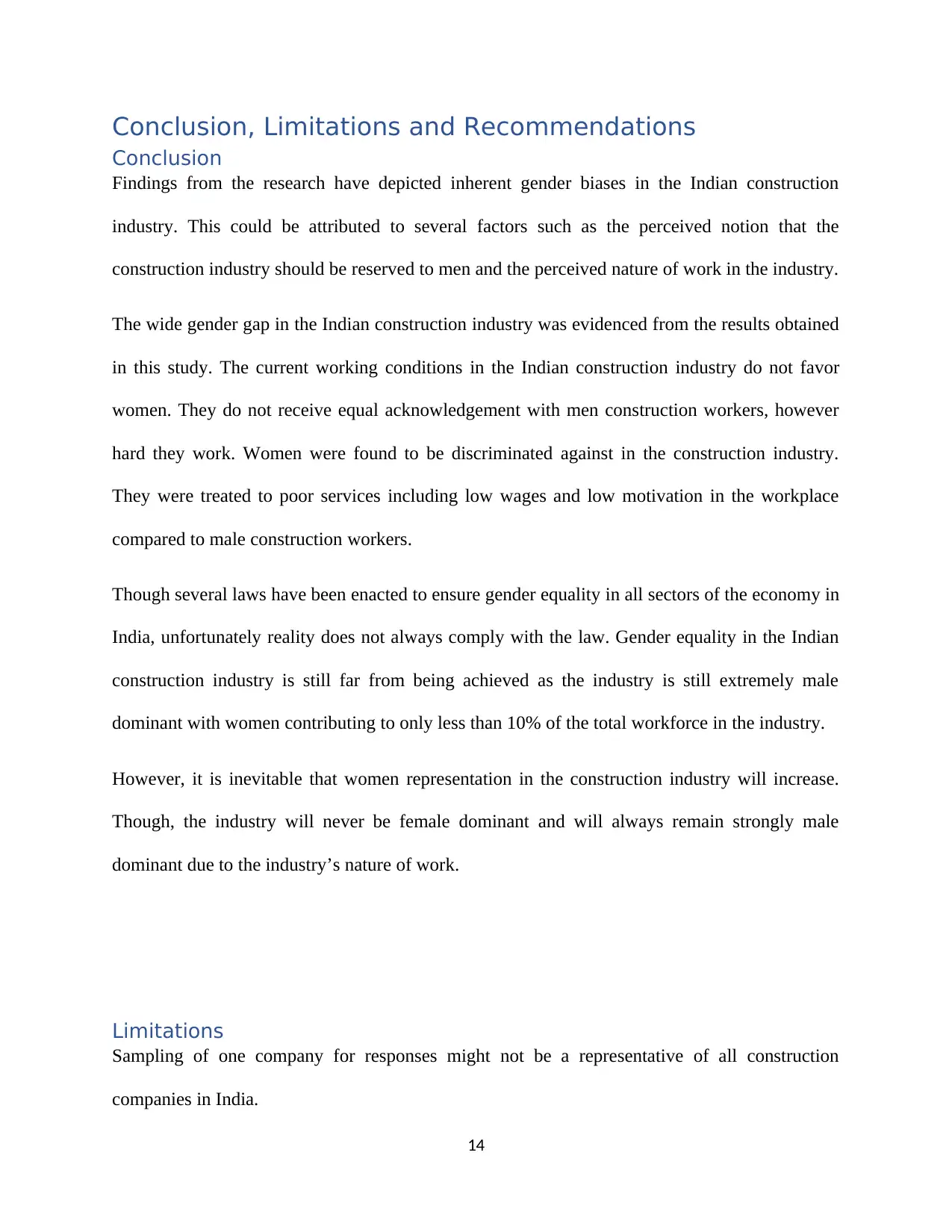
Conclusion, Limitations and Recommendations
Conclusion
Findings from the research have depicted inherent gender biases in the Indian construction
industry. This could be attributed to several factors such as the perceived notion that the
construction industry should be reserved to men and the perceived nature of work in the industry.
The wide gender gap in the Indian construction industry was evidenced from the results obtained
in this study. The current working conditions in the Indian construction industry do not favor
women. They do not receive equal acknowledgement with men construction workers, however
hard they work. Women were found to be discriminated against in the construction industry.
They were treated to poor services including low wages and low motivation in the workplace
compared to male construction workers.
Though several laws have been enacted to ensure gender equality in all sectors of the economy in
India, unfortunately reality does not always comply with the law. Gender equality in the Indian
construction industry is still far from being achieved as the industry is still extremely male
dominant with women contributing to only less than 10% of the total workforce in the industry.
However, it is inevitable that women representation in the construction industry will increase.
Though, the industry will never be female dominant and will always remain strongly male
dominant due to the industry’s nature of work.
Limitations
Sampling of one company for responses might not be a representative of all construction
companies in India.
14
Conclusion
Findings from the research have depicted inherent gender biases in the Indian construction
industry. This could be attributed to several factors such as the perceived notion that the
construction industry should be reserved to men and the perceived nature of work in the industry.
The wide gender gap in the Indian construction industry was evidenced from the results obtained
in this study. The current working conditions in the Indian construction industry do not favor
women. They do not receive equal acknowledgement with men construction workers, however
hard they work. Women were found to be discriminated against in the construction industry.
They were treated to poor services including low wages and low motivation in the workplace
compared to male construction workers.
Though several laws have been enacted to ensure gender equality in all sectors of the economy in
India, unfortunately reality does not always comply with the law. Gender equality in the Indian
construction industry is still far from being achieved as the industry is still extremely male
dominant with women contributing to only less than 10% of the total workforce in the industry.
However, it is inevitable that women representation in the construction industry will increase.
Though, the industry will never be female dominant and will always remain strongly male
dominant due to the industry’s nature of work.
Limitations
Sampling of one company for responses might not be a representative of all construction
companies in India.
14
Secure Best Marks with AI Grader
Need help grading? Try our AI Grader for instant feedback on your assignments.
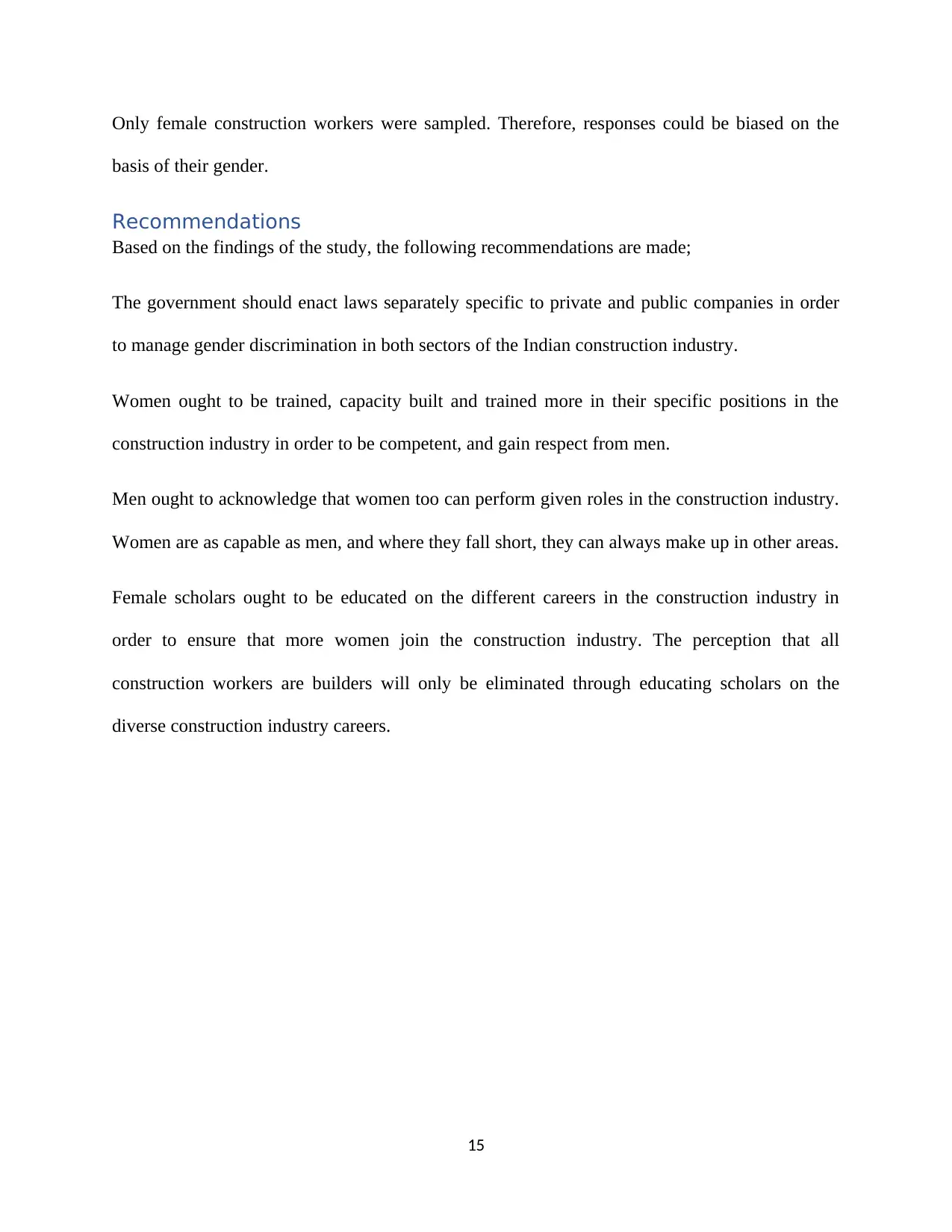
Only female construction workers were sampled. Therefore, responses could be biased on the
basis of their gender.
Recommendations
Based on the findings of the study, the following recommendations are made;
The government should enact laws separately specific to private and public companies in order
to manage gender discrimination in both sectors of the Indian construction industry.
Women ought to be trained, capacity built and trained more in their specific positions in the
construction industry in order to be competent, and gain respect from men.
Men ought to acknowledge that women too can perform given roles in the construction industry.
Women are as capable as men, and where they fall short, they can always make up in other areas.
Female scholars ought to be educated on the different careers in the construction industry in
order to ensure that more women join the construction industry. The perception that all
construction workers are builders will only be eliminated through educating scholars on the
diverse construction industry careers.
15
basis of their gender.
Recommendations
Based on the findings of the study, the following recommendations are made;
The government should enact laws separately specific to private and public companies in order
to manage gender discrimination in both sectors of the Indian construction industry.
Women ought to be trained, capacity built and trained more in their specific positions in the
construction industry in order to be competent, and gain respect from men.
Men ought to acknowledge that women too can perform given roles in the construction industry.
Women are as capable as men, and where they fall short, they can always make up in other areas.
Female scholars ought to be educated on the different careers in the construction industry in
order to ensure that more women join the construction industry. The perception that all
construction workers are builders will only be eliminated through educating scholars on the
diverse construction industry careers.
15
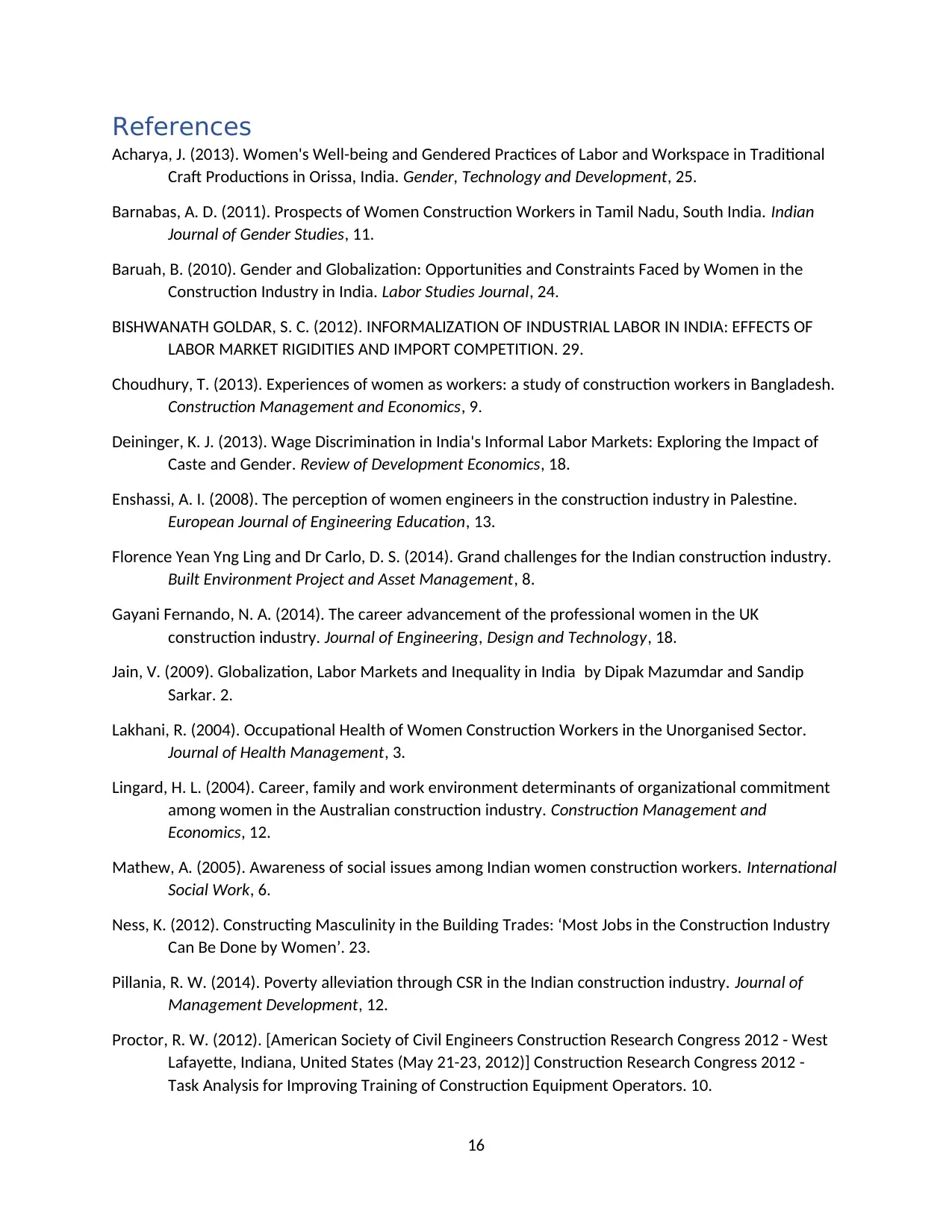
References
Acharya, J. (2013). Women's Well-being and Gendered Practices of Labor and Workspace in Traditional
Craft Productions in Orissa, India. Gender, Technology and Development, 25.
Barnabas, A. D. (2011). Prospects of Women Construction Workers in Tamil Nadu, South India. Indian
Journal of Gender Studies, 11.
Baruah, B. (2010). Gender and Globalization: Opportunities and Constraints Faced by Women in the
Construction Industry in India. Labor Studies Journal, 24.
BISHWANATH GOLDAR, S. C. (2012). INFORMALIZATION OF INDUSTRIAL LABOR IN INDIA: EFFECTS OF
LABOR MARKET RIGIDITIES AND IMPORT COMPETITION. 29.
Choudhury, T. (2013). Experiences of women as workers: a study of construction workers in Bangladesh.
Construction Management and Economics, 9.
Deininger, K. J. (2013). Wage Discrimination in India's Informal Labor Markets: Exploring the Impact of
Caste and Gender. Review of Development Economics, 18.
Enshassi, A. I. (2008). The perception of women engineers in the construction industry in Palestine.
European Journal of Engineering Education, 13.
Florence Yean Yng Ling and Dr Carlo, D. S. (2014). Grand challenges for the Indian construction industry.
Built Environment Project and Asset Management, 8.
Gayani Fernando, N. A. (2014). The career advancement of the professional women in the UK
construction industry. Journal of Engineering, Design and Technology, 18.
Jain, V. (2009). Globalization, Labor Markets and Inequality in India by Dipak Mazumdar and Sandip
Sarkar. 2.
Lakhani, R. (2004). Occupational Health of Women Construction Workers in the Unorganised Sector.
Journal of Health Management, 3.
Lingard, H. L. (2004). Career, family and work environment determinants of organizational commitment
among women in the Australian construction industry. Construction Management and
Economics, 12.
Mathew, A. (2005). Awareness of social issues among Indian women construction workers. International
Social Work, 6.
Ness, K. (2012). Constructing Masculinity in the Building Trades: ‘Most Jobs in the Construction Industry
Can Be Done by Women’. 23.
Pillania, R. W. (2014). Poverty alleviation through CSR in the Indian construction industry. Journal of
Management Development, 12.
Proctor, R. W. (2012). [American Society of Civil Engineers Construction Research Congress 2012 - West
Lafayette, Indiana, United States (May 21-23, 2012)] Construction Research Congress 2012 -
Task Analysis for Improving Training of Construction Equipment Operators. 10.
16
Acharya, J. (2013). Women's Well-being and Gendered Practices of Labor and Workspace in Traditional
Craft Productions in Orissa, India. Gender, Technology and Development, 25.
Barnabas, A. D. (2011). Prospects of Women Construction Workers in Tamil Nadu, South India. Indian
Journal of Gender Studies, 11.
Baruah, B. (2010). Gender and Globalization: Opportunities and Constraints Faced by Women in the
Construction Industry in India. Labor Studies Journal, 24.
BISHWANATH GOLDAR, S. C. (2012). INFORMALIZATION OF INDUSTRIAL LABOR IN INDIA: EFFECTS OF
LABOR MARKET RIGIDITIES AND IMPORT COMPETITION. 29.
Choudhury, T. (2013). Experiences of women as workers: a study of construction workers in Bangladesh.
Construction Management and Economics, 9.
Deininger, K. J. (2013). Wage Discrimination in India's Informal Labor Markets: Exploring the Impact of
Caste and Gender. Review of Development Economics, 18.
Enshassi, A. I. (2008). The perception of women engineers in the construction industry in Palestine.
European Journal of Engineering Education, 13.
Florence Yean Yng Ling and Dr Carlo, D. S. (2014). Grand challenges for the Indian construction industry.
Built Environment Project and Asset Management, 8.
Gayani Fernando, N. A. (2014). The career advancement of the professional women in the UK
construction industry. Journal of Engineering, Design and Technology, 18.
Jain, V. (2009). Globalization, Labor Markets and Inequality in India by Dipak Mazumdar and Sandip
Sarkar. 2.
Lakhani, R. (2004). Occupational Health of Women Construction Workers in the Unorganised Sector.
Journal of Health Management, 3.
Lingard, H. L. (2004). Career, family and work environment determinants of organizational commitment
among women in the Australian construction industry. Construction Management and
Economics, 12.
Mathew, A. (2005). Awareness of social issues among Indian women construction workers. International
Social Work, 6.
Ness, K. (2012). Constructing Masculinity in the Building Trades: ‘Most Jobs in the Construction Industry
Can Be Done by Women’. 23.
Pillania, R. W. (2014). Poverty alleviation through CSR in the Indian construction industry. Journal of
Management Development, 12.
Proctor, R. W. (2012). [American Society of Civil Engineers Construction Research Congress 2012 - West
Lafayette, Indiana, United States (May 21-23, 2012)] Construction Research Congress 2012 -
Task Analysis for Improving Training of Construction Equipment Operators. 10.
16
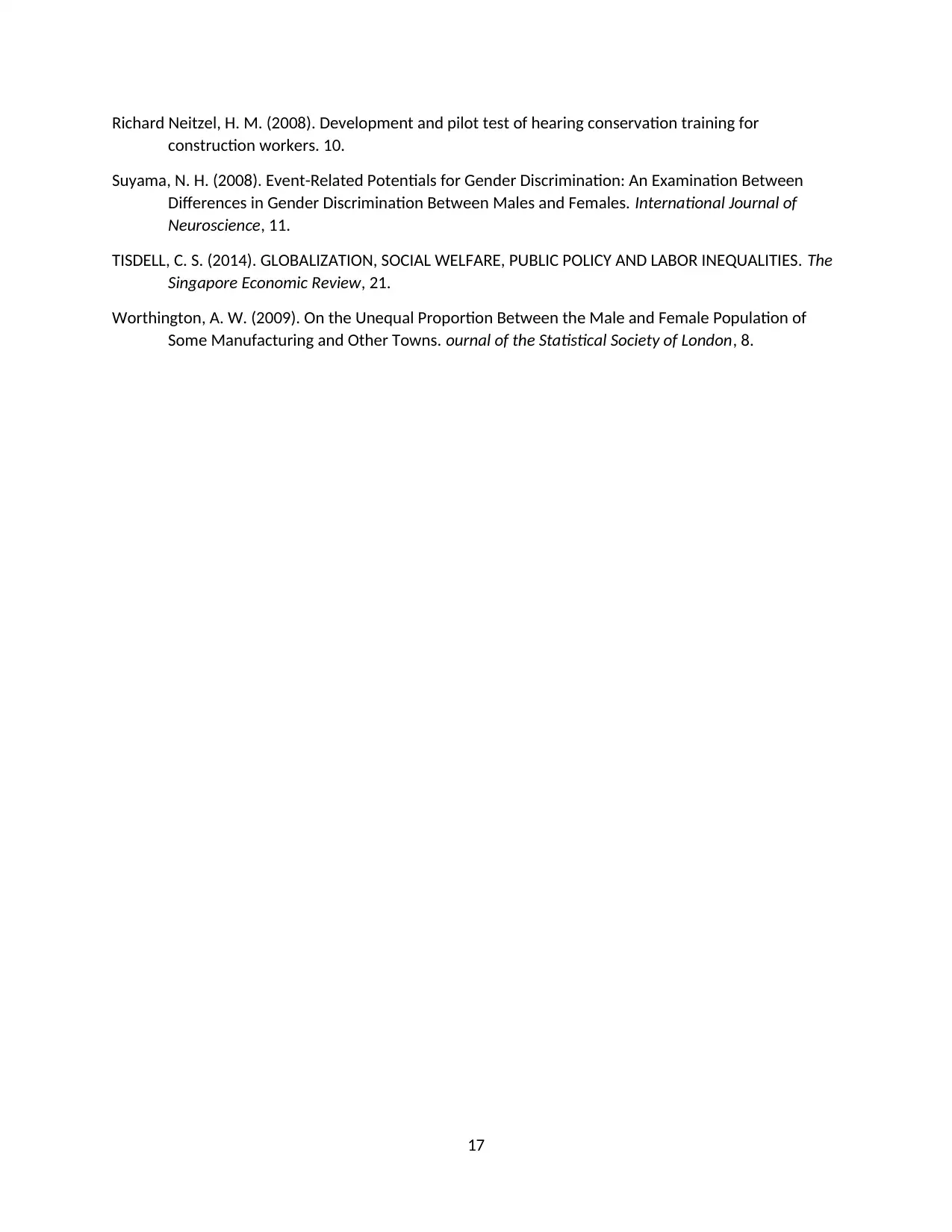
Richard Neitzel, H. M. (2008). Development and pilot test of hearing conservation training for
construction workers. 10.
Suyama, N. H. (2008). Event-Related Potentials for Gender Discrimination: An Examination Between
Differences in Gender Discrimination Between Males and Females. International Journal of
Neuroscience, 11.
TISDELL, C. S. (2014). GLOBALIZATION, SOCIAL WELFARE, PUBLIC POLICY AND LABOR INEQUALITIES. The
Singapore Economic Review, 21.
Worthington, A. W. (2009). On the Unequal Proportion Between the Male and Female Population of
Some Manufacturing and Other Towns. ournal of the Statistical Society of London, 8.
17
construction workers. 10.
Suyama, N. H. (2008). Event-Related Potentials for Gender Discrimination: An Examination Between
Differences in Gender Discrimination Between Males and Females. International Journal of
Neuroscience, 11.
TISDELL, C. S. (2014). GLOBALIZATION, SOCIAL WELFARE, PUBLIC POLICY AND LABOR INEQUALITIES. The
Singapore Economic Review, 21.
Worthington, A. W. (2009). On the Unequal Proportion Between the Male and Female Population of
Some Manufacturing and Other Towns. ournal of the Statistical Society of London, 8.
17
Paraphrase This Document
Need a fresh take? Get an instant paraphrase of this document with our AI Paraphraser
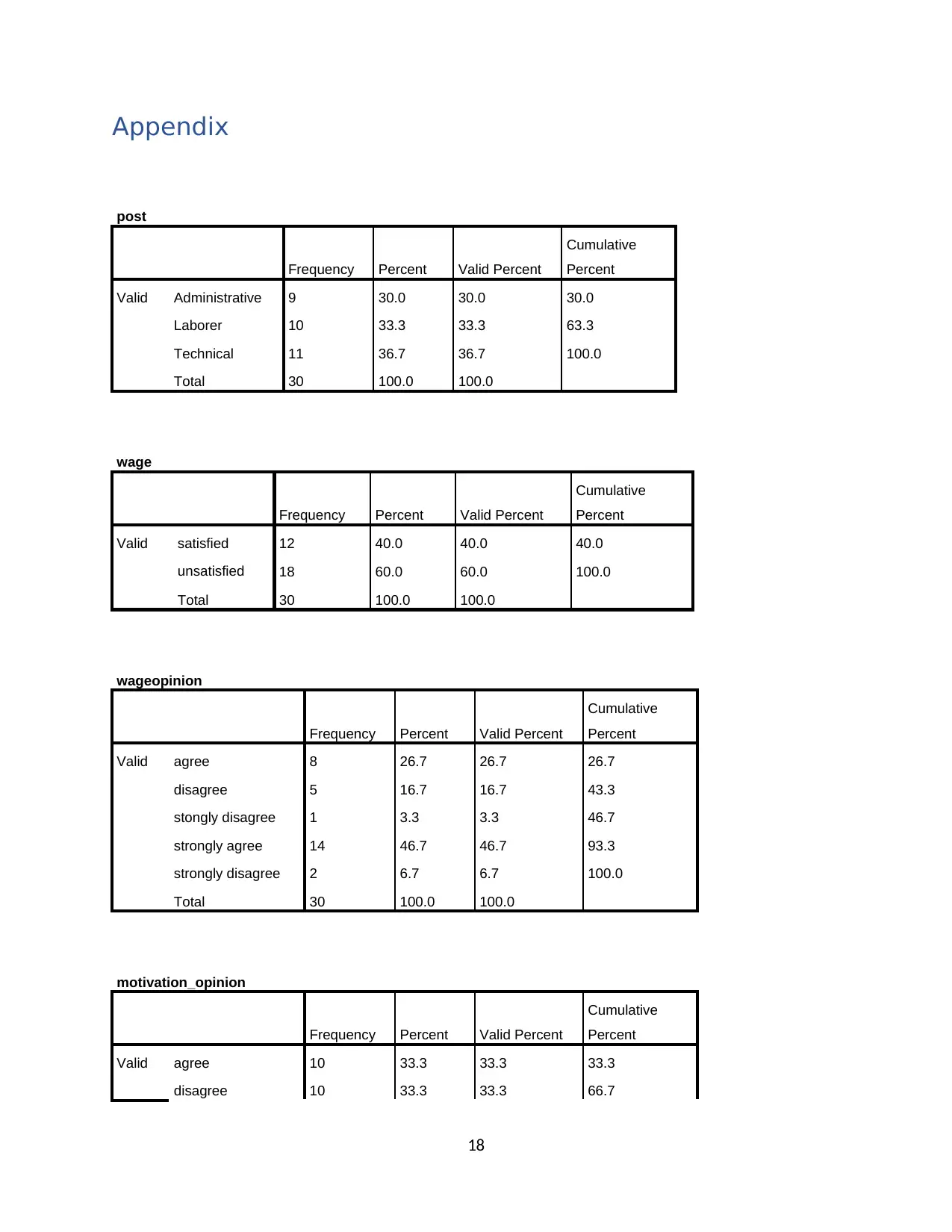
Appendix
post
Frequency Percent Valid Percent
Cumulative
Percent
Valid Administrative 9 30.0 30.0 30.0
Laborer 10 33.3 33.3 63.3
Technical 11 36.7 36.7 100.0
Total 30 100.0 100.0
wage
Frequency Percent Valid Percent
Cumulative
Percent
Valid satisfied 12 40.0 40.0 40.0
unsatisfied 18 60.0 60.0 100.0
Total 30 100.0 100.0
wageopinion
Frequency Percent Valid Percent
Cumulative
Percent
Valid agree 8 26.7 26.7 26.7
disagree 5 16.7 16.7 43.3
stongly disagree 1 3.3 3.3 46.7
strongly agree 14 46.7 46.7 93.3
strongly disagree 2 6.7 6.7 100.0
Total 30 100.0 100.0
motivation_opinion
Frequency Percent Valid Percent
Cumulative
Percent
Valid agree 10 33.3 33.3 33.3
disagree 10 33.3 33.3 66.7
18
post
Frequency Percent Valid Percent
Cumulative
Percent
Valid Administrative 9 30.0 30.0 30.0
Laborer 10 33.3 33.3 63.3
Technical 11 36.7 36.7 100.0
Total 30 100.0 100.0
wage
Frequency Percent Valid Percent
Cumulative
Percent
Valid satisfied 12 40.0 40.0 40.0
unsatisfied 18 60.0 60.0 100.0
Total 30 100.0 100.0
wageopinion
Frequency Percent Valid Percent
Cumulative
Percent
Valid agree 8 26.7 26.7 26.7
disagree 5 16.7 16.7 43.3
stongly disagree 1 3.3 3.3 46.7
strongly agree 14 46.7 46.7 93.3
strongly disagree 2 6.7 6.7 100.0
Total 30 100.0 100.0
motivation_opinion
Frequency Percent Valid Percent
Cumulative
Percent
Valid agree 10 33.3 33.3 33.3
disagree 10 33.3 33.3 66.7
18

strongly agree 7 23.3 23.3 90.0
strongly disagree 3 10.0 10.0 100.0
Total 30 100.0 100.0
19
strongly disagree 3 10.0 10.0 100.0
Total 30 100.0 100.0
19
1 out of 21
Related Documents
Your All-in-One AI-Powered Toolkit for Academic Success.
+13062052269
info@desklib.com
Available 24*7 on WhatsApp / Email
![[object Object]](/_next/static/media/star-bottom.7253800d.svg)
Unlock your academic potential
© 2024 | Zucol Services PVT LTD | All rights reserved.





